Well, here we go with the third and final in a series of blahgs where I try to trace musical star Linda Keene through the media. If you haven’t read the first two parts, TRACING LINDA KEENE, PART 1: THE FLORENCE SUTTLE YEARS or TRACING LINDA KEENE, PART 2: THE MOMENT IN MY LIFE then do yourself a favour and stop now and check out those two blahgs. If you’ve arrived here or returned here after reading the first two parts then you know I’m trying to trace the life of the great but forgotten singer Linda Keene through her notices, reviews, advertisements, and photos in the media. This post will have a great surprise at the end and if you want to skip ahead to check it out, I wouldn’t blame you but I’m hoping you stick it through from the beginning. This blahg will pick up where the last one left off but a quick word about the title. I can’t tell you that right now but when you get to the end, and the big reveal, you will understand the title. I think it’s a more respectful title to end this final blahg on tracing Linda Keene.
1946
When I last left off, Linda Keene was finishing up 1945 at the Village Vanguard in New York. In February of 1945 she had also recorded the last of her official recordings supervised by her good friend Leonard Feather with a group of musicians including Charlie Shavers on trumpet and Red Norvo on vibes. Linda had once toured with Norvo and was at Kelly’s Stable in 1944 with Charlie Shavers. The sum total of her official recordings were 21 songs starting with her first recording of “Blue and Disillusioned” with Bobby Hackett’s band in November of 1938 through recordings with Jack Teagarden in 1939, Lennie Hayton also in late 1939 and again in early 1940, a single with Tony Pastor in 1941, a 78rpm album containing six vocals from Linda with Henry Levine and his band in February of 1942, then two recordings with Joe Marsala in November 1944, followed by the last recordings in 1945 with Charlie Shavers, Red Norvo, and group. There were also three Soundies with Levine in 1942; which you will understand if you checked out part two of this blahg series. There were no further orchestra or band affiliations by the end of 1945 and all of Linda’s future appearances would be club dates.
I’m not sure when her engagement at the Village Vanguard came to an end. Billboard reviewed her there on December 19th, also see part two of my Linda Keene series, and mentioned she went into the Village Vanguard on the 18th. Variety failed to mention her in the Variety Bills section for the whole month of December. The last listing for the Village Vanguard in the December 26, 1945 issue of Variety looked liked this:

The January 2nd issue of Variety had the following billing for the Village Vanguard for the week of January 3rd:
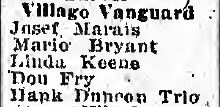
Variety would carry the same billing well into February with only a slight change-up in their February 27th issue for the week of the 28th:

The last Village Vanguard billing listed in Variety that carried Linda Keene’s name was in the March 13th, 1946 issue for the week of March 14th:
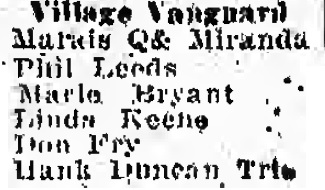
It looked like a very long engagement for Linda Keene at the Village Vanguard from December 18th, 1945 to mid-March 1946.
The first newspaper notice for Linda Keene in 1946 appeared in the Daily News (New York, New York) on January 20, 1946:
This was a radio listing for an appearance for Linda Keene on a radio program called “Battle of Music.” Further research turned up an article in The Times Dispatch (Richmond, Virginia) also on January 20th:
That article from The Times Dispatch explains a little of the format of Classical vs. Pop tunes. We also learn that Linda Keene, misspelled here as Linda Keane, sang “My Guy’s Come Back” and “Blues in the Night” backed by Ken Delmar. A similar article would appear in the Indianapolis Star, Indianapolis, Indiana, on January 26th:
I checked the radio listings for January 26th in Indianapolis and the show aired from 6 to 6:30pm on WIRE 1430. This means that if the show aired six days after the initial airing on January 20th then there must have been a transcription recording of the program to air on the later dates. I have yet to find a transcription for the program. I have also found this program listed as the “RCA Show”, “RCA Victor Show”, and “RCA Victor Program”. Of the two songs sung by Linda Keene, “Blues In The Night” is the more famous of the two, having been written in 1942 with an excellent recording in the same year by Dinah Shore. “My Guy’s Come Back” was written in 1945 by Ray McKinley and Mel Powell with three recordings of the song made in the same year. Liza Morrow recorded it with Benny Goodman and his Orchestra, while another recording was of Helen Forrest with Mannie Klein’s Orchestra, and Dinah Shore also recorded this one with Russ Case and his Orchestra. You can view/hear all three recordings on YouTube:
“My Guy’s Come Back” is an interesting swing tune so I wonder what Linda Keene would have done with it. “Blues In The Night” certainly would have been more suited to her.
A very small but interesting article appeared in the New York Daily News on January 29th, 1946 shortly after Linda Keene’s appearance on “Battle of Music.”  It seems that Linda Keene, who was credited at being at the Village Vanguard, was being considered for Dick Kollmar’s new musical, “Windy City.” Unfortunately, Linda was either busy or was not offered a part. The musical would play at the Shubert Theater in late April 1946 in Philadelphia and would be reviewed in the May 6th edition of Billboard:
It seems that Linda Keene, who was credited at being at the Village Vanguard, was being considered for Dick Kollmar’s new musical, “Windy City.” Unfortunately, Linda was either busy or was not offered a part. The musical would play at the Shubert Theater in late April 1946 in Philadelphia and would be reviewed in the May 6th edition of Billboard:
It is probably a good thing that Linda Keene stayed on at the Village Vanguard. According to the website, http://operetta-research-center.org/world-premiere-recording-walter-jurmanns-windy-city/, “Windy City opened in New Haven on April 18, 1946, in Philadelphia on April 23, in Boston on April 30, and in Chicago on May 16. Per usual during this out-of-town tryout period, the book was tweaked and songs were added, subtracted, and shifted around. The 12-day gap between the May 4 closing in Boston and the Chicago opening was necessitated by a major overhaul of the script and the attendant extra rehearsal time.” Apparently the musical play was not well received and didn’t last long in Chicago. From the same website, the poster below is from the play’s run at the Shubert Theatre in New Haven, Connecticut on April 18, 1946. I guess there was more than one Shubert Theatre where this play ran.

If we assume that Linda Keene finished at the Village Vanguard sometime during the middle of March then the next big announcement for her came about a week later.  The Hanover Evening Sun, Hanover, PA on March 23rd carried a small article about some upcoming changes due for Kelly’s Stable in New York. Kelly’s Stable had undergone some changes to expand seating and would reopen on April 4th, 1946 with Linda Keene in the lineup. A week later on March 30th, the Hanover Evening Sun
The Hanover Evening Sun, Hanover, PA on March 23rd carried a small article about some upcoming changes due for Kelly’s Stable in New York. Kelly’s Stable had undergone some changes to expand seating and would reopen on April 4th, 1946 with Linda Keene in the lineup. A week later on March 30th, the Hanover Evening Sun affirmed that the reopening with Linda Keene was still set for April 4th adding the names of Nan Blackstone, The Osmund Sisters, and Nellie Hill. Despite the two articles stating that Linda Keene would take part in the reopening of Kelly’s Stable,
affirmed that the reopening with Linda Keene was still set for April 4th adding the names of Nan Blackstone, The Osmund Sisters, and Nellie Hill. Despite the two articles stating that Linda Keene would take part in the reopening of Kelly’s Stable,  Variety did not list her among the first week performers.
Variety did not list her among the first week performers. 
Billboard published a review of the reopening in the April 13th edition but Linda Keene is not mentioned. Nan Blackstone gets a good nod and Nellie Hill, who wasn’t listed in the Variety roster for the first week of April also is reviewed. Variety did include Linda Keene’s name in their performer 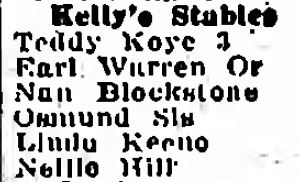 list for Kelly’s Stable for the week of April 11th.
list for Kelly’s Stable for the week of April 11th.
B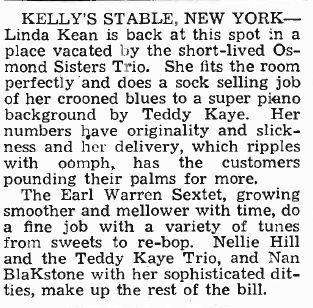 illboard also published another review of Kelly’s Stable in their April 27th edition and specifically singled out Linda Keene; even if they did misspell her last name as “Kean.”
illboard also published another review of Kelly’s Stable in their April 27th edition and specifically singled out Linda Keene; even if they did misspell her last name as “Kean.”
Variety would continue to list Linda Keene a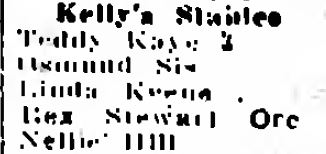 mong the performers at Kelly’s Stable in the May 1st, 8th, and 15th editions. Gone was Nan Blackstone but Rex Stewart’s Orchestra had been added. Linda Keene’s name was also appearing in ads for Kelly’s Stable published in the Princeton Daily Princetonian, Princeton, New Jersey on May 3rd and May 10th:
mong the performers at Kelly’s Stable in the May 1st, 8th, and 15th editions. Gone was Nan Blackstone but Rex Stewart’s Orchestra had been added. Linda Keene’s name was also appearing in ads for Kelly’s Stable published in the Princeton Daily Princetonian, Princeton, New Jersey on May 3rd and May 10th:
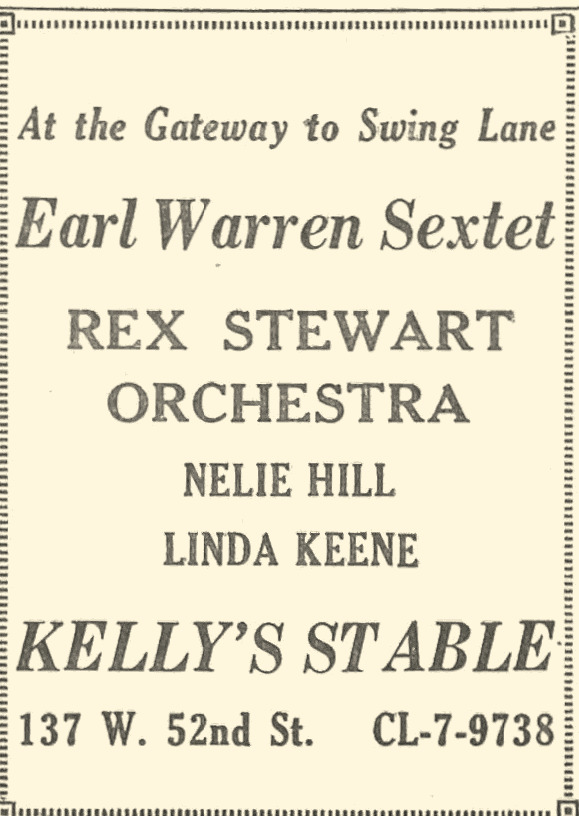 However, by the time of the May 22nd, 1946 edition of Variety, Linda Keene was not in their review of Kelly’s Stable and Rex Stewart’s Orchestra had moved on as well.
However, by the time of the May 22nd, 1946 edition of Variety, Linda Keene was not in their review of Kelly’s Stable and Rex Stewart’s Orchestra had moved on as well. 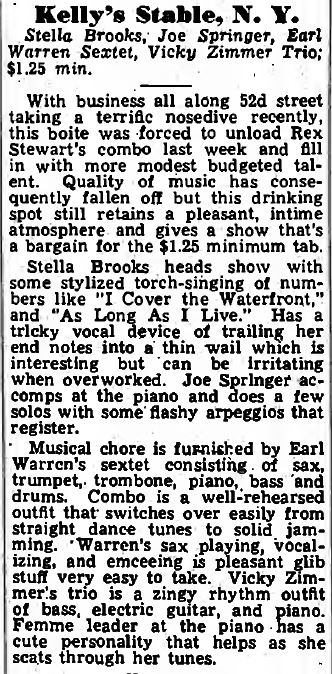
Neither Variety or Billboard would carry any club reviews or route information for Linda Keene for the rest of 1946. 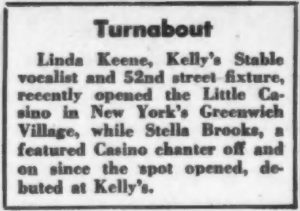 At some point, however, Linda was at the Little Casino in New York’s Greenwich Village in June of that year. Down Beat made a mention of it in their June 3rd edition.
At some point, however, Linda was at the Little Casino in New York’s Greenwich Village in June of that year. Down Beat made a mention of it in their June 3rd edition.
Nothing is noted of Linda Keene after that until a small notice appears in  The Miami Herald (Miami, Florida) on August 9th. Linda Keene opened at the Blackamoor Room in Miami for two weeks, closing on August 22nd. Linda had last made an appearance in Florida on April 27th, 1942 with Tony Pastor and His Orchestra. Linda would receive some good press throughout her engagement at the Blackamoor but the
The Miami Herald (Miami, Florida) on August 9th. Linda Keene opened at the Blackamoor Room in Miami for two weeks, closing on August 22nd. Linda had last made an appearance in Florida on April 27th, 1942 with Tony Pastor and His Orchestra. Linda would receive some good press throughout her engagement at the Blackamoor but the 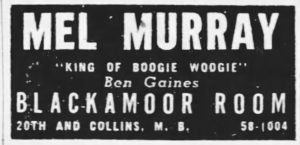 advertisement that ran in Miami newspapers would not mention her appearance.
advertisement that ran in Miami newspapers would not mention her appearance.
Linda Keene’s run at the Blackamoor, as mentioned, generated some generally good press with at least one featuring her picture:
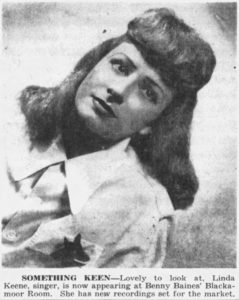 The Miami News (Miami, Florida), August 10, 1946
The Miami News (Miami, Florida), August 10, 1946
There were some good reviews as well of Linda at the Blackamoor. On August 14th, The Miami Herald praised her singing: 
It’s interesting that the reviewer mentions Linda Keene’s recordings of “Unlucky Woman” and “Blow-Top Blues” both on the Victor label. This was wrong on two accounts. First, “Unlucky Woman” was recorded by Linda Keene with Joe Marsala and His Orchestra on November 29th, 1944 for the Black & White label. Second, Linda did not record “Blow-Top Blues.” It was a tune written by her friend Leonard Feather and Linda had been singing it for a while, including during her engagement at the Village Vanguard in New York in December of 1945 which was reviewed in Billboard and included in my last blahg TRACING LINDA KEENE, PART 2: THE MOMENT IN MY LIFE. I could add third, Linda had not recorded for the Victor label since February of 1942 with Henry Levine. Note that the Miami News article from August 10th, with Linda’s picture, also mentioned “she has new recordings set for the market.” I can find no other recordings for Linda that had been produced in 1946.
Other reviews of Linda at the Blackamoor 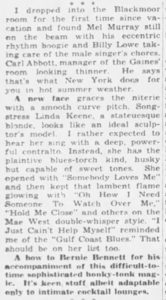 also praised her singing and mentioned songs she was performing. The one on the left from the Miami News on August 16th mentions her singing “Somebody Loves Me” and “Someone To Watch Over Me” which were two of the six tunes she recorded with Henry Levine in February of 1942. I’m not sure what the song “Hold Me Close” refers to. It could be the song “La Vie En Rose” which was written in 1945 and was popular throughout 1946 and well associated with Édith Piaf. It contains the lyrics “Hold me close and hold me fast. The magic spell you cast This is la vie en rose.” I’m not familiar with the song “I Just Can’t Help Myself.” This too, could be a misquoted title where the lyrics contained the phrase “I Just Can’t Help Myself.” It’s odd that the Miami News gave a positive nod to Bernie Bennett’s accompaniment
also praised her singing and mentioned songs she was performing. The one on the left from the Miami News on August 16th mentions her singing “Somebody Loves Me” and “Someone To Watch Over Me” which were two of the six tunes she recorded with Henry Levine in February of 1942. I’m not sure what the song “Hold Me Close” refers to. It could be the song “La Vie En Rose” which was written in 1945 and was popular throughout 1946 and well associated with Édith Piaf. It contains the lyrics “Hold me close and hold me fast. The magic spell you cast This is la vie en rose.” I’m not familiar with the song “I Just Can’t Help Myself.” This too, could be a misquoted title where the lyrics contained the phrase “I Just Can’t Help Myself.” It’s odd that the Miami News gave a positive nod to Bernie Bennett’s accompaniment 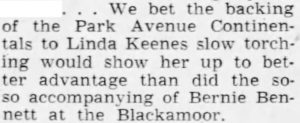 of Linda Keene but the August 21st Miami Herald didn’t care for Bennett’s Orchestra.
of Linda Keene but the August 21st Miami Herald didn’t care for Bennett’s Orchestra.
While performing at the Blackamoor, Linda Keene was also called upon to make a personal appearance with Bernie Bennett at a local hospital: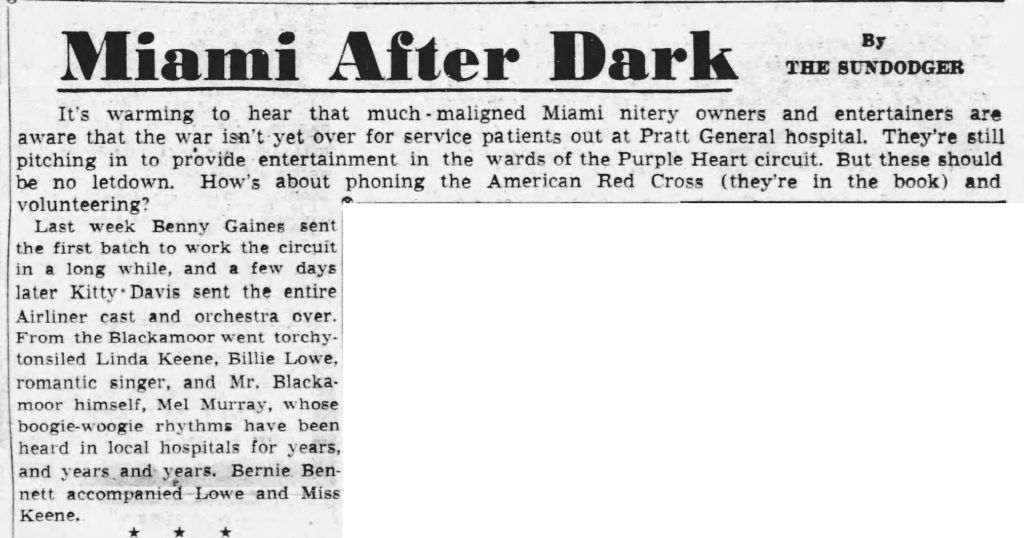 That article appeared in the August 18th, Miami Herald. The last significant article mentioning Linda Keene appeared in The Miami News on August 21st.
That article appeared in the August 18th, Miami Herald. The last significant article mentioning Linda Keene appeared in The Miami News on August 21st. 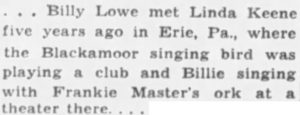 Billy Lowe was the male singer talent at the Blackamoor while Linda Keene was appearing there. The article mentions that “Billy Lowe met Linda Keene five years ago in Erie, Pa.,” where she had been singing at a local club and Lowe was appearing with Frankie Masters’ Orchestra. I tried to trace the exact time that Billy Lowe and Linda Keene might have appeared five years earlier at separate venues in Erie, Pennsylvania. Frankie Masters’ Orchestra was appearing at venues in Pennsylvania in July of 1941 but none of the advertisements or articles mentioned Billy Lowe. Most articles suggested that Lowe didn’t join up with Masters until the summer/fall of 1941. I did find an advertisement from the Pittsburgh Press (Pittsburgh, Pennsylvania) from October 30th, 1942 that put Masters and Lowe in Pittsburgh, Pennsylvania at the end of October 1942:
Billy Lowe was the male singer talent at the Blackamoor while Linda Keene was appearing there. The article mentions that “Billy Lowe met Linda Keene five years ago in Erie, Pa.,” where she had been singing at a local club and Lowe was appearing with Frankie Masters’ Orchestra. I tried to trace the exact time that Billy Lowe and Linda Keene might have appeared five years earlier at separate venues in Erie, Pennsylvania. Frankie Masters’ Orchestra was appearing at venues in Pennsylvania in July of 1941 but none of the advertisements or articles mentioned Billy Lowe. Most articles suggested that Lowe didn’t join up with Masters until the summer/fall of 1941. I did find an advertisement from the Pittsburgh Press (Pittsburgh, Pennsylvania) from October 30th, 1942 that put Masters and Lowe in Pittsburgh, Pennsylvania at the end of October 1942:
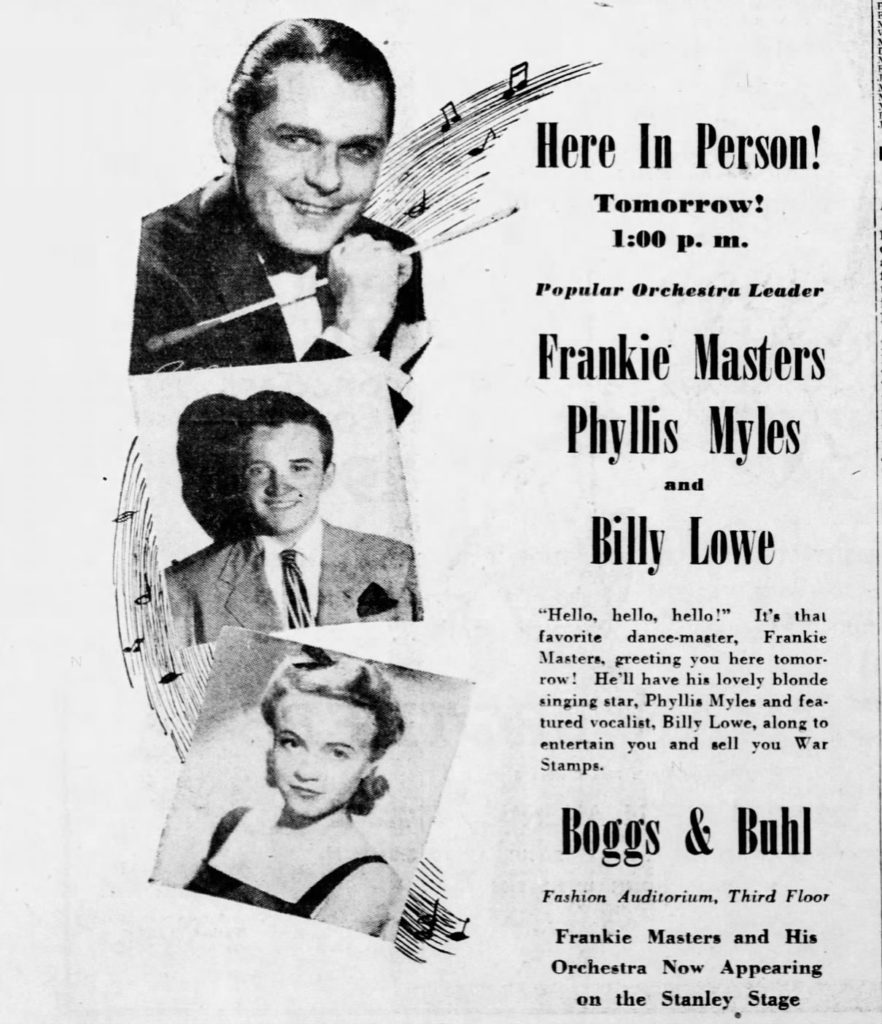 Linda Keene was not in Pennsylvania at that time. Linda was in Cincinnati, Ohio at The Patio for two weeks opening on October 19th and closing on November 1st. Billy Lowe’s memory might have been faulty on the year or it might have been another city or a different month in 1942 or possibly 1943. Starting January 18th, 1943 Linda was featured at the Tropical Room of the Hotel Bolton in Harrisburg, Pennsylvania, ending on January 24th. I could find no recordings of Lowe with Masters but Phyllis Myles who also appeared with Frankie Masters was married to Masters. Here’s a nice recording of Myles with Masters on their March 31st, 1947 version of “If This Isn’t Love”:
Linda Keene was not in Pennsylvania at that time. Linda was in Cincinnati, Ohio at The Patio for two weeks opening on October 19th and closing on November 1st. Billy Lowe’s memory might have been faulty on the year or it might have been another city or a different month in 1942 or possibly 1943. Starting January 18th, 1943 Linda was featured at the Tropical Room of the Hotel Bolton in Harrisburg, Pennsylvania, ending on January 24th. I could find no recordings of Lowe with Masters but Phyllis Myles who also appeared with Frankie Masters was married to Masters. Here’s a nice recording of Myles with Masters on their March 31st, 1947 version of “If This Isn’t Love”:
Linda Keene’s last notice 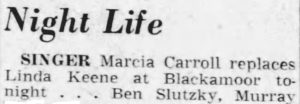 in Floridas was from the August 23rd Miami Herald when it was announced that Marcia Carroll was replacing her that night at the Blackamoor.
in Floridas was from the August 23rd Miami Herald when it was announced that Marcia Carroll was replacing her that night at the Blackamoor.
Just over two weeks after Linda Keene finished at the Blackamoor in Miami, she headed north and crossed into Canada to Gatineau, Quebec.  On Saturday, September 7th, the Ottawa Citizen, Ottawa, Ontario, Canada, ran an advertisement for the Gatineau Club noting that Linda Keene would start on the Monday, September 9th. Gatineau is directly across the Ottawa River from Ottawa, Ontario about ten kilometres or six miles away. On September 10th, the Ottawa Citizen ran a nice picture and article of Linda Keene at the Gatineau Club:
On Saturday, September 7th, the Ottawa Citizen, Ottawa, Ontario, Canada, ran an advertisement for the Gatineau Club noting that Linda Keene would start on the Monday, September 9th. Gatineau is directly across the Ottawa River from Ottawa, Ontario about ten kilometres or six miles away. On September 10th, the Ottawa Citizen ran a nice picture and article of Linda Keene at the Gatineau Club: 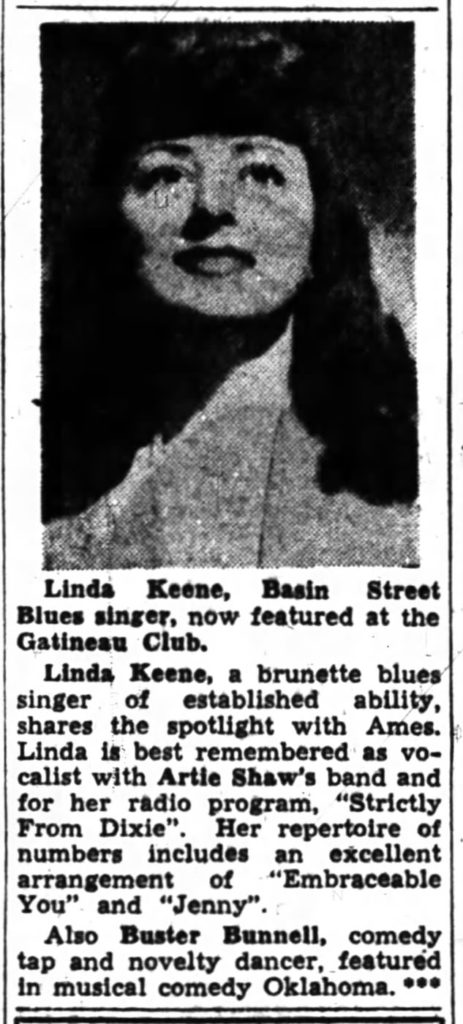
I’m not sure where the Ottawa Citizen obtained the information that Linda Keene was primarily remembered as a vocalist with Artie Shaw. In my previous blahg I posted the article to the right as a wire service article from  February of 1942 that stated that Linda Keene had turned down an offer from Artie Shaw. At least The Ottawa Citizen was correct about her appearance on the “Strictly From Dixie” program.
February of 1942 that stated that Linda Keene had turned down an offer from Artie Shaw. At least The Ottawa Citizen was correct about her appearance on the “Strictly From Dixie” program.
A similar advertisement with picture appeared in the Citizen on September 11th and 12th.
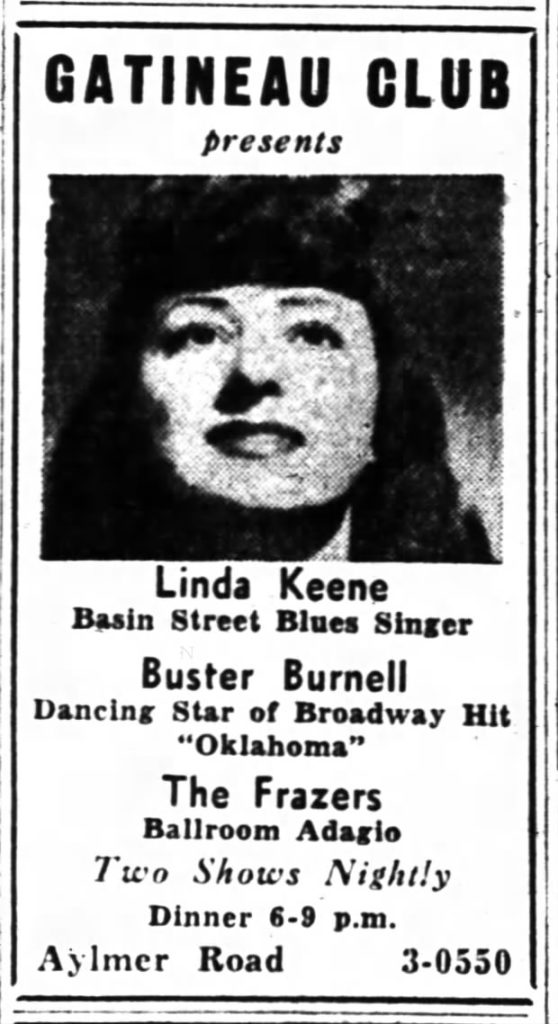 This certainly was a better ongoing advertisement than the one that appeared during her time at the Blackamoor. Linda’s initial run at the Gatineau Club was for a week but was extended.
This certainly was a better ongoing advertisement than the one that appeared during her time at the Blackamoor. Linda’s initial run at the Gatineau Club was for a week but was extended. 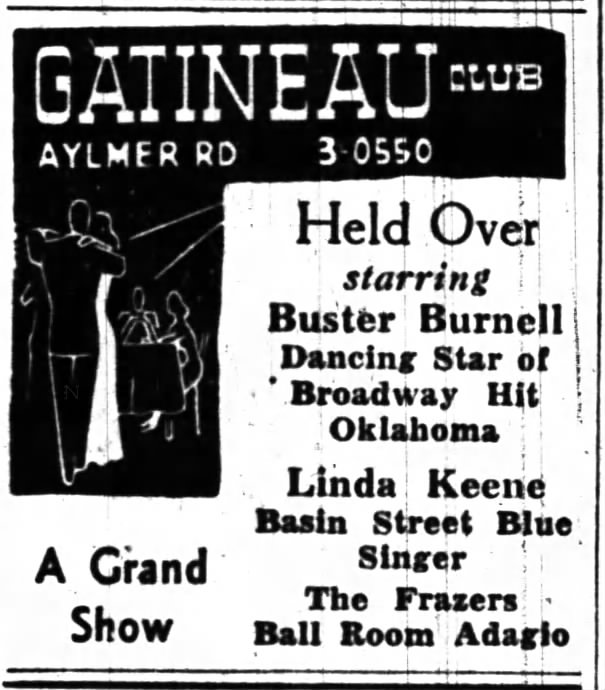 On September 19th the Ottawa Citizen noted in the new ad for the Gatineau Club that everyone had been held over. Her two week engagement likely ended on September 23rd, which coincidentally is my Birthday, as new shows generally started on Mondays and she would have closed on the Sunday the 23rd.
On September 19th the Ottawa Citizen noted in the new ad for the Gatineau Club that everyone had been held over. Her two week engagement likely ended on September 23rd, which coincidentally is my Birthday, as new shows generally started on Mondays and she would have closed on the Sunday the 23rd.
Before I move on to Linda Keene’s next appearance in 1946, I want to post a Soundies review from the September 9th, 1946 Billboard.
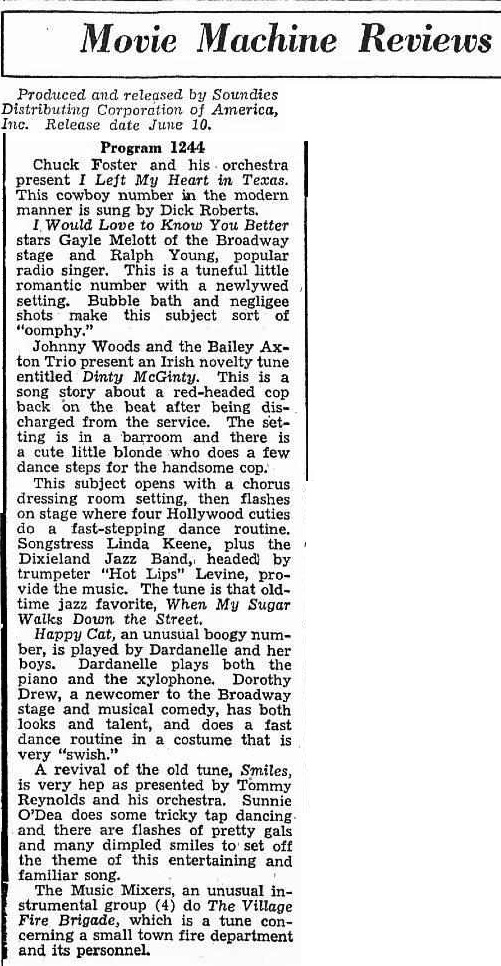 I posted about Soundies and included Youtube links to Linda Keene’s Soundies in my last blahg, TRACING LINDA KEENE, PART 2: THE MOMENT IN MY LIFE. Here is what I explained about Soundies:
I posted about Soundies and included Youtube links to Linda Keene’s Soundies in my last blahg, TRACING LINDA KEENE, PART 2: THE MOMENT IN MY LIFE. Here is what I explained about Soundies:
“Soundies are three-minute American musical films, produced between 1940 and 1947, each containing a song, dance, and/or band or orchestral number. Produced professionally on 35mm black-and-white film, like theatrical motion pictures, they were printed in the more portable and economical 16mm gauge.
The films were shown in a coin-operated “movie jukebox” called the Panoram, manufactured by the Mills Novelty Company of Chicago. Each Panoram housed a 16mm RCA film projector, with eight Soundies films threaded in an endless-loop arrangement. A system of mirrors flashed the image from the lower half of the cabinet onto a front-facing screen in the top half. Each film cost 10 cents to play, and there was no choice of song; the patron saw whatever film was next in the queue. Panorams could be found in public amusement centers, nightclubs, taverns, restaurants, and factory lounges, and the films were changed weekly. The completed Soundies were generally made available within a few weeks of their filming, by the Soundies Distributing Corporation of America.”
Linda Keene made three Soundies with Henry Levine and his Jazz Band in the spring of 1942, “Ja-Da”, “Frankie and Johnny”, and “When My Sugar Walks Down The Street.” The Billboard review above gives us the program of Soundies that included “When My Sugar Walks Down The Street”. If you wanted to see that particular one, you had to watch all of the ones that preceded it in the program and the one that followed. I thought it would be interesting to recreate that Soundie program by posting each here for your viewing pleasure. Unfortunately I could not find the Soundie for “I Left My Heart In Texas” by Chuck Foster but I did find a video of a live remote (audio only) of that song by Foster:
Next up is “I’d Love To Know You Better with Gayle Melott and Ralph Young. Unfortunately, it is no longer on YouTube but you can view it here: https://www.historicfilms.com/tapes/18338_2557_2557
Unfortunately, I could not find “Dinty McGinty” featuring Johnny Woods with the Bailey Axton Trio. If anyone can locate it, please let me know.
After “Dinty McGinty” of course was “When My Sugar Walks Down The Street” with Linda Keene and Henry Levine.
After Linda Keene came Dorothy Drew dancing to the accompaniment of Dardanelle and her Boys on “Happy Cat”. The version here appears to be abridged:
Following “Happy Cat” came Tommy Reynolds and His Orchestra” playing “Smiles” while Sunnie O’Dea danced:
Finally, if you got through all of those then you were treated to “We’re The Village Fire Brigade” by the Music Mixers. Alas, that Soundie is also not available for viewing. Program 1244 of Soundies was probably a repackaging because Linda Keene’s effort was from 1942 as was “I’d Love To Know You Beter” and “Smiles”, “I Left My Heart In Texas” was from 1945, while “Dingty McGinty”, “Happy Cat” and “The Village Fire Brigade” were relatively new for 1946.  As always, “The Soundies Book” by Scott MacGillivray and Ted Okuda is a great resource. Clearly by 1946, Soundies were coming to an end and repackaging of the new with the old was a way to keep things going. According to MacGillivray and Okuda:
As always, “The Soundies Book” by Scott MacGillivray and Ted Okuda is a great resource. Clearly by 1946, Soundies were coming to an end and repackaging of the new with the old was a way to keep things going. According to MacGillivray and Okuda:
“Soundies’ flurry of activity in 1946 was not sufficient to keep the company solvent, and the Soundies Distributing Corporation discontinued operations. William Forest Crouch tried to keep the brand name going himself, doing business as Soundies Films, Inc. and applying for Soundies copyrights in 1947. His last few Soundies, released in March 1947 were cobbled together from cutting-room film clips.”
In October of 1946, Linda Keene’s name appeared in The Evening Sun (Baltimore, Maryland) on October 14th. The advertisement was a novelty advertisement for the 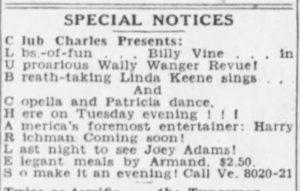 Club Charles using all of the letters of that name to spell out reasons to attend performances at the Club. “B” was for Breath-taking Linda Keene sings. The highlight of the show was of course Billy Vine, comic, who featured prominently in the advertisement in The Evening Sun on October 15th when the show opened:
Club Charles using all of the letters of that name to spell out reasons to attend performances at the Club. “B” was for Breath-taking Linda Keene sings. The highlight of the show was of course Billy Vine, comic, who featured prominently in the advertisement in The Evening Sun on October 15th when the show opened: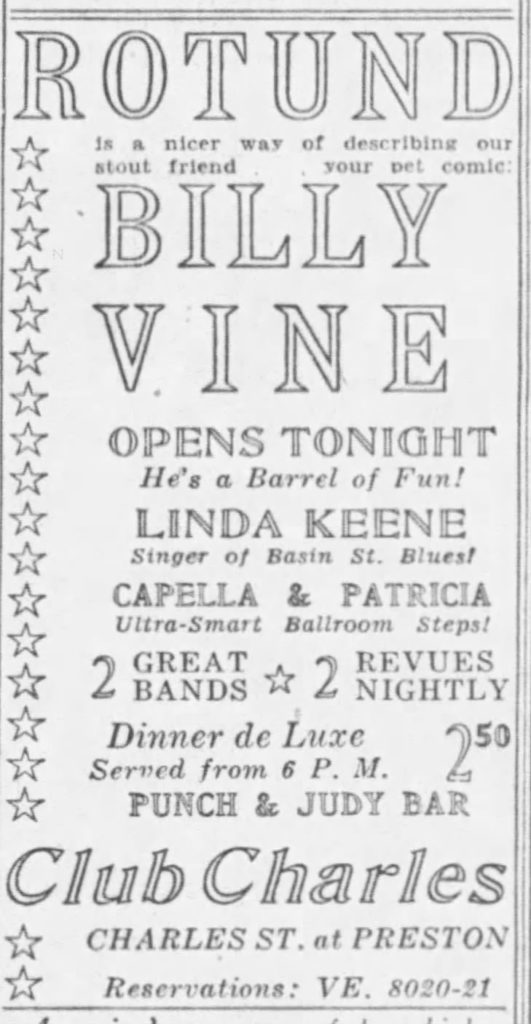
Billy Vine would be featured in other Club Charles advertisements until he closed on October 28th. Linda was not mentioned in any other advertisements but it’s possible she was only there for the two weeks. 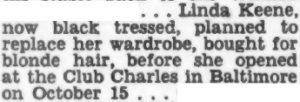 Linda had last appeared at the Club Charles in January of 1945 and before that in mid-June of 1943. Down Beat made note of her appearance in their October 21st issue and the fact that her hair color had changed. As for Billy Vine, he would die of a heart attack in 1958 at the age of 44.
Linda had last appeared at the Club Charles in January of 1945 and before that in mid-June of 1943. Down Beat made note of her appearance in their October 21st issue and the fact that her hair color had changed. As for Billy Vine, he would die of a heart attack in 1958 at the age of 44.
Media references for Linda Keene were difficult to find over the next year. I could find nothing for her for the remainder of 1946 and it was well into 1947 before I could find her name in print again.
1947
By 1947, Linda Keene’s fame was on the decline. She may have been playing club dates but the media coverage of her appearances were difficult to locate. She had not made a recording since February of 1945 and her radio appearances had dwindled as well. The only radio appearances I could document prior to 1947 had been her appearance in January of 1946 on “Battle of Music” and before that her last guest spot had been on “Everything For The Girls” back in December of 1944. Her screen-test in 1944 had not produced a film career, Soundies were fading fast and she hadn’t made a new one of those since 1942, and her consideration for musicals such as “Windy City” failed to produce results. The remainder of Linda Keene’s career that produced any media coverage was her club work.
The next notice for Linda Keene was not until July of 1947.  The only print that Linda Keene would receive from Billboard magazine in 1947 was the one from July 26th when they mentioned her as part of the program at the Susie Q club. What Billboard failed to mention was that the Susie Q was on Hollywood Boulevard in Los Angeles. Linda Keene was back on the west coast for the first time since early of 1944 where she was playing at the Little Club in Hollywood.
The only print that Linda Keene would receive from Billboard magazine in 1947 was the one from July 26th when they mentioned her as part of the program at the Susie Q club. What Billboard failed to mention was that the Susie Q was on Hollywood Boulevard in Los Angeles. Linda Keene was back on the west coast for the first time since early of 1944 where she was playing at the Little Club in Hollywood. 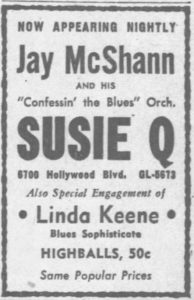 The same day, July 26th, that Billboard had the notice for Linda at the Susie Q, an advertisement for her appearance ran in The Los Angeles Times. This same advertisement was published in the August 2nd edition of the Los Angeles Times suggesting another two week engagement.
The same day, July 26th, that Billboard had the notice for Linda at the Susie Q, an advertisement for her appearance ran in The Los Angeles Times. This same advertisement was published in the August 2nd edition of the Los Angeles Times suggesting another two week engagement.
Why was Linda Keene back on the West Coast in July of 1947? The major clue comes from Opal L. Nations’ article “Unlucky Woman – The Story of Linda Keene.”
“A later report in Down Beat announced that Keene had married Burleigh Smith in Shreveport, Louisiana on February 12th, 1947 and that they had both settled down in Los Angeles. Smith was a long-established radio announcer. They found a new manager named Stillman Pond who worked tirelessly on Keene’s behalf. The entertainment business was changing. A film short called “Bitter Street” and a feature film with Bob Crosby with the working title ‘Champagne for Everybody’ fizzled out at the last moment. Her second marriage lasted only a year.”
The article mentions a marriage to Burleigh Smith in Shreveport Louisiana on February 12th, 1947 but a search of the Shreveport newspapers from that time failed to produce any results. This was, of course, not her second marriage because her first had been to Spurgeon Suttle in September of 1931 and there was a second marriage that lasted four days in September of 1944.  Opal Nations’ article does clarify that Linda and Burleigh had taken up residence in Los Angeles which explains why Linda Keene was appearing at the Susie Q. Down Beat would also post a photo and article of Linda Keene in their August 27th, 1947 edition, noting that Linda was out of the Suzie Q and waiting for her next engagement:
Opal Nations’ article does clarify that Linda and Burleigh had taken up residence in Los Angeles which explains why Linda Keene was appearing at the Susie Q. Down Beat would also post a photo and article of Linda Keene in their August 27th, 1947 edition, noting that Linda was out of the Suzie Q and waiting for her next engagement:
Down Beat would report in their September 10th issue on some problems at the Suzie Q and why Linda Keene was no longer there:
Opal Nations’ made reference to Linda’s new manager, Stillman Pond and a short film to star Linda called “Bitter Street”. On September 11th, 1947, the California Eagle (Los Angeles, California) published an article about a party recently held by Stillman Pond with Linda Keene as guest of honor. The article mentions “Bitter Street” and some other projects being considered for Linda Keene:
Of course, we already know that “Bitter Street” was never made but it’s interesting to note that Linda Keene was being considered for a feature entitled “My Old Flame” and another short called “Black Night and Fog”. Sam Coslow, who accompanied Linda Keene when she sang “My Old Flame” at the party, was co-author of the song with Arthur Johnston. The song was first recorded by Mae West in 1934 and was obviously still getting traction in 1947. Charlie Barnet, with whom Linda had been linked to in 1941, actually released a version in 1947 with Jean Louise doing the vocals:
“My Old Flame” was a great ballad and I think Linda Keene would have performed a great version of the standard. There was no film produced with the title of “My Old Flame” nor a short with a title “Black Night And Fog.” There was a song from around that time with the title “Black Night And Fog” attributed to Boyd Raeburn and his Orchestra. There exists a radio transcription of “Black Night And Fog” from 1946 by Boyd Raeburn and his Orchestra with vocal by David Allyn:
It is an interesting blues type ballad which might have suited Linda Keene but there is no evidence she ever sang it in any of her club appearances. It seems that the only thing that resulted from Stillman Pond’s party was the news article above and the following photo that appeared in the California Eagle (Los Angeles, California) on September 18th, 1947:
Down Beat would also cover the party in their September 24th, 1947 issue:
The notices for Linda Keene at the Susie Q were the last notices for 1947 that I could find for her with the exception of an article in the September 3rd edition of Variety.  The article was primarily about vocalist Bob Davey and his upcoming radio program, “The Blues and Bob.” It was going to have a format similar to the “Chamber Music Society of Lower Basin Street” and would include Linda Keene on the program. I searched extensively but could find no reference to Bob Davey and certainly listings for “The Blues and Bob” on old time radio sites failed to turn up anything. Another potential project for Linda Keene that failed to materialize.
The article was primarily about vocalist Bob Davey and his upcoming radio program, “The Blues and Bob.” It was going to have a format similar to the “Chamber Music Society of Lower Basin Street” and would include Linda Keene on the program. I searched extensively but could find no reference to Bob Davey and certainly listings for “The Blues and Bob” on old time radio sites failed to turn up anything. Another potential project for Linda Keene that failed to materialize.
1948
Again, the notices for Linda Keene were sparser and sparser. She may have been working but she certainly wasn’t getting the coverage she would get in previous years. Her first media coverage in 1948 was probably one she really didn’t want.  On March 6th, 1948, wire services were carrying notices that Linda Keene
On March 6th, 1948, wire services were carrying notices that Linda Keene 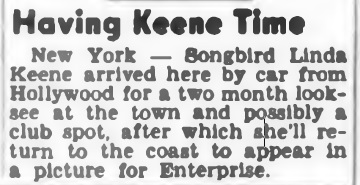
 was divorcing Burleigh Smith. Down Beat from April 21st, 1948 made reference in two articles to the divorce and that Linda had travelled to New York. Following that announcement, Linda Keene is located the following month back on the East Coast playing at
was divorcing Burleigh Smith. Down Beat from April 21st, 1948 made reference in two articles to the divorce and that Linda had travelled to New York. Following that announcement, Linda Keene is located the following month back on the East Coast playing at 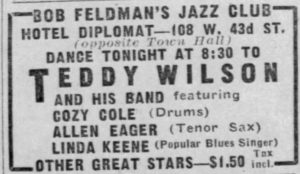 Bob Feldman’s Jazz Club in the Hotel Diplomat in New York. The advertisement to the right is from the Daily News (New York, New York) April 9th, 1948.
Bob Feldman’s Jazz Club in the Hotel Diplomat in New York. The advertisement to the right is from the Daily News (New York, New York) April 9th, 1948. 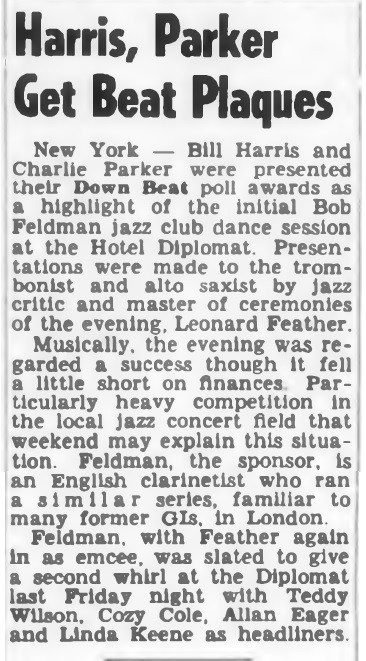 Down Beat also ran an article about Linda’s appearance at the Diplomat in their April 21st, 1948 edition. The article to the left mentioned Linda as headliner on the previous Friday. It was probably referencing the Friday before that being April 9th which is when the advertisement above noted she was there. The following flyer card of her appearance at the Hotel Diplomat confirms the opening as April 9th, 1948:
Down Beat also ran an article about Linda’s appearance at the Diplomat in their April 21st, 1948 edition. The article to the left mentioned Linda as headliner on the previous Friday. It was probably referencing the Friday before that being April 9th which is when the advertisement above noted she was there. The following flyer card of her appearance at the Hotel Diplomat confirms the opening as April 9th, 1948:
The April 21st, 1948 edition of Down Beat also noted in their Band Routes section that Linda was also at the Club James at some point in April 1948: ![]()
Referring back to Opal Nations’ article he had this to say about Linda Keene after her marriage to Burleigh Smith came to an end:
“A final trip was made to New York. Work for Keene’s type of act was close to non-existent. She found one gig in Akron, Ohio after which she returned home to Los Angeles.”
The “gig in Akron” was at ![]() Senior’s Yankee Inn where she opened on June 14th, 1948. The article to the left and the advertisement for the opening night both come from the Akron Beacon Journal on June 14th. The advertisement prominently featured her name and stated that she had just come from the Blue Angel in New York.
Senior’s Yankee Inn where she opened on June 14th, 1948. The article to the left and the advertisement for the opening night both come from the Akron Beacon Journal on June 14th. The advertisement prominently featured her name and stated that she had just come from the Blue Angel in New York.
I checked the New York papers as well as Billboard and Variety for the first six months of 1948 and Linda Keene was not listed in any of the advertisements or talent rosters for the Blue Angel. Other advertisements for Linda Keene at the Yankee Inn appeared in the Akron Beacon Journal on June 18th
and on June 23rd:
On June 25th the advertisement for the Yankee Inn had a new performer starting on the Monday, June 27th.
This was another two week engagement for Linda. She had played Akron before, both times at the Summit Beach Park. In September of 1935 she had appeared there with George Duffy and his Orchestra under her married name Florence Suttle and returned as Linda Keene in June of 1941 with Muggsy Spanier’s Orchestra. Both had been single night performances. It was no doubt better for her to have a two week run in Akron than having to pack up and change venues in different cities every night.
1949
It would be over a year after her Akron engagement at the Yankee Inn before I could trace Linda Keene again in the media. By July of 1949, she was back on the West Coast, in Los Angeles, and she was settling in for a two month stay at Larry Potter’s Supper Club. The advertisement below from the July 2nd, 1949 Los Angeles Times notes Linda Keene as a special added attraction opening July 5th . Linda Keene’s engagement at Larry Potter’s received notices from the July 5th opening to her September 5th closing. Below are some of the other advertisements that appeared during those two months:
Linda Keene’s engagement at Larry Potter’s received notices from the July 5th opening to her September 5th closing. Below are some of the other advertisements that appeared during those two months:
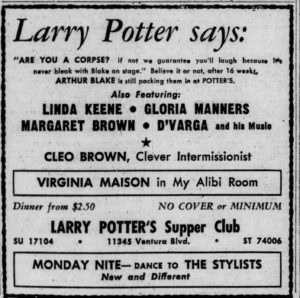 The Los Angeles Times, August 20, 1949
The Los Angeles Times, August 20, 1949
 The Los Angeles Times, August 27, 1949
The Los Angeles Times, August 27, 1949
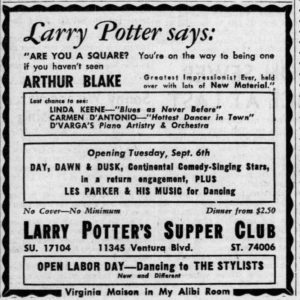 The Los Angeles Times, September 3rd, 1949
The Los Angeles Times, September 3rd, 1949
On July 9th, 1949 Linda Keene made an appearance on KECA, a radio station in Los Angeles. T he article on the right is from the Los Angeles Evening Citizen News (Hollywood, California) on July 9th and mentions her appearance along with Sidney Miller. When I checked the radio listings for KECA at 9pm on July 9th, the listing indicated the program was called “Buzz Adlam’s Playroom”.
he article on the right is from the Los Angeles Evening Citizen News (Hollywood, California) on July 9th and mentions her appearance along with Sidney Miller. When I checked the radio listings for KECA at 9pm on July 9th, the listing indicated the program was called “Buzz Adlam’s Playroom”. ![]() I could find no other information about her appearance or what songs she might have performed.
I could find no other information about her appearance or what songs she might have performed. 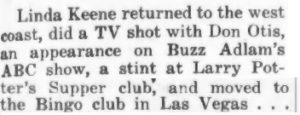 Down Beat mentioned the Playroom appearance in their August 12th edition but also stated she had made a TV appearance as well with Don Otis.
Down Beat mentioned the Playroom appearance in their August 12th edition but also stated she had made a TV appearance as well with Don Otis. 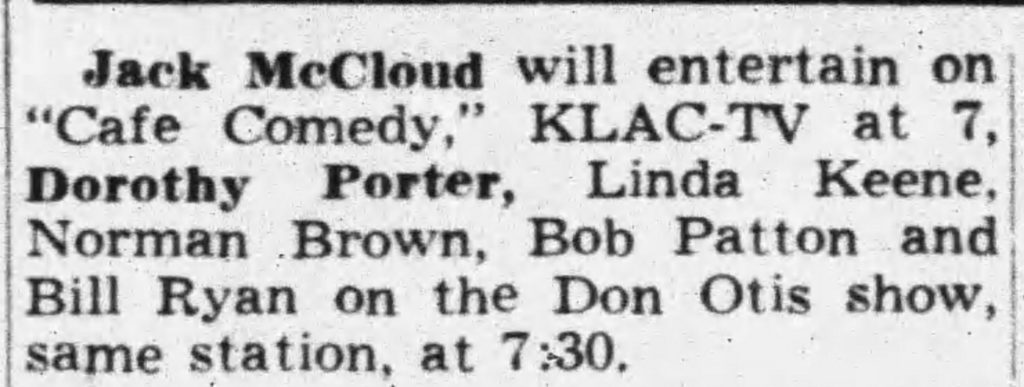 The article to the left is for the Don Otis appearance on June 21st, 1949 and appeared in that day’s Los Angeles Evening Citizen News.
The article to the left is for the Don Otis appearance on June 21st, 1949 and appeared in that day’s Los Angeles Evening Citizen News.
On July 9th, the same day as Linda appeared on “Buzz Adlam’s Playroom”, Larry Potter’s ran the following advertisement in the Mirror News (Los Angeles, California):
The Mirror News (Los Angeles, California) also printed the following article to highlight Linda’s appearance at Larry Potter’s Supper Club:
Linda was still getting traction from her appearance with Glenn Miller more than a decade before. Of course her career had not started with Glenn Miller but Miller’s name was big enough that associating Linda Keene’s name with him was probably good for business.
During the latter half of her engagement at Larry Potter’s Supper Club, and sometimes after the engagement had concluded, a small wire service article would mention Linda Keene. I found this article appearing as late as September 18th in the Asheville Citizen-Times (Asheville, North Carolina), almost two weeks after Linda had left Larry Potter’s. I have tried to find some information on the song “Ingrid Couldn’t Help It” or a song that included those words in the lyrics but could find nothing. It’s interesting that Linda Keene was getting such odd press for her appearance at Larry Potter’s in Los Angeles in papers as far away as North Carolina. Was the significance the song or the singer?
I found this article appearing as late as September 18th in the Asheville Citizen-Times (Asheville, North Carolina), almost two weeks after Linda had left Larry Potter’s. I have tried to find some information on the song “Ingrid Couldn’t Help It” or a song that included those words in the lyrics but could find nothing. It’s interesting that Linda Keene was getting such odd press for her appearance at Larry Potter’s in Los Angeles in papers as far away as North Carolina. Was the significance the song or the singer?
It’s interesting to note that Linda Keene was mentioned in advertisements for Larry Potter’s in Los Angeles from July 5th to September 5th 1949 yet she was also advertised as appearing in Las Vegas in July at the Club Bingo. The following advertisement from the Las Vegas Review Journal, July 22nd, 1949, indicated that Linda Keene opened at the Club Bingo on July 22nd:
On July 25th, the Las Vegas Review Journal published a positive review for Linda Keene at the Club Bingo:
The only other reference for Linda at the Club Bingo 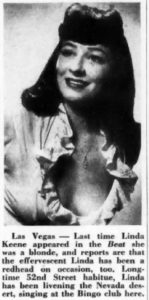 was in the August 26th, 1949 issue of Down Beat and they once again focus on her hair color.
was in the August 26th, 1949 issue of Down Beat and they once again focus on her hair color.
Club Bingo was not the only venue in Nevada that featured Linda Keene in 1949. In September, Linda was spotted in Reno at the Hotel Mapes. The Nevada State Journal featured a fair sized advertisement for Linda’s appearance the evening of September 8, 1949:
The advertisement for the Hotel Mapes on September 11th, just 3 days later, failed to mention Linda Keene:
A new show started on September 15th and Linda’s name was missing from that advertisement as well:
It is not clear if Linda was at the Hotel Mapes in Reno for the whole week or only for a couple of nights.
Another oddity, I will also throw in here was another wire service article making the rounds in mid-October. Arnold Ross was a jazz pianist living in California in the late 1940s. From 1944 to 1947 he worked with Harry James; around the same time he played with Harry Edison, Charlie Ventura, and Charlie Parker. He moved to California in 1947, working with Lena Horne, Dizzy Gillespie, Bob Crosby, and Billy Eckstine, in addition to leading his own small group. I could find nothing else about the relationship between Linda Keene and Arnold Ross and whether the relationship was professional or personal.
Arnold Ross was a jazz pianist living in California in the late 1940s. From 1944 to 1947 he worked with Harry James; around the same time he played with Harry Edison, Charlie Ventura, and Charlie Parker. He moved to California in 1947, working with Lena Horne, Dizzy Gillespie, Bob Crosby, and Billy Eckstine, in addition to leading his own small group. I could find nothing else about the relationship between Linda Keene and Arnold Ross and whether the relationship was professional or personal.
On November 25, 1949, the Greensburg Daily News (Greensburg, Indiana), published a small article that Linda Keene was opening at The Blue Angel in San Francisco on December 1st.
published a small article that Linda Keene was opening at The Blue Angel in San Francisco on December 1st.  It seems that the Blue Angel used to be the Club Cortez.
It seems that the Blue Angel used to be the Club Cortez.  Down Beat, in the January 13, 1950 issue would explain that the Blue Angel opening was actually delayed by three weeks with Linda opening on December 23rd.
Down Beat, in the January 13, 1950 issue would explain that the Blue Angel opening was actually delayed by three weeks with Linda opening on December 23rd.  Down Beat also mentioned her closing at the Blue Angel, ending her run on January 5th of 1950, with a small article in the February 10, 1950 issue. The reference to Reno is curious because I could find nothing else to suggest another marriage at that time.
Down Beat also mentioned her closing at the Blue Angel, ending her run on January 5th of 1950, with a small article in the February 10, 1950 issue. The reference to Reno is curious because I could find nothing else to suggest another marriage at that time.
1950
A new decade and Linda Keene was still out there trying. She was 38 years old by the end of 1949 and in a couple of years she would be 40. By 1950 she was on her own again without a husband, a movie career, new recordings, or a radio program. Television was in its infancy and offered lots of opportunity with variety show programming but there is no information that suggests Linda even tried television. 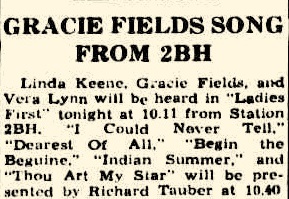 Speaking of radio, her next media notice, and the first that I could find for 1950, was an odd article from the Broken Hill Barrier Miner, Broken Hill, New South Wales, Australia on February 10, 1950. It was a notice for a radio program called “Ladies First” on which Linda Keene, Gracie Fields, and Vera Lynn would be heard. I could find no other information about the program and whether these were live performances or a disc-jockey spinning records by these three great ladies.
Speaking of radio, her next media notice, and the first that I could find for 1950, was an odd article from the Broken Hill Barrier Miner, Broken Hill, New South Wales, Australia on February 10, 1950. It was a notice for a radio program called “Ladies First” on which Linda Keene, Gracie Fields, and Vera Lynn would be heard. I could find no other information about the program and whether these were live performances or a disc-jockey spinning records by these three great ladies.
The same day that the Broken Hill Barrier Miner notice appeared on February 10, 1950, the Los Angeles Times reported that Linda Keene was back at Larry Potter’s Supper Club:
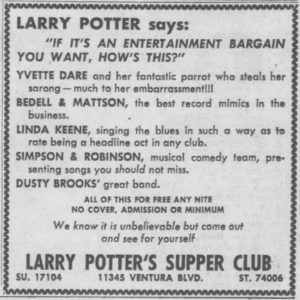 Linda had been at Larry Potter’s the previous year for a two month engagement from July 5th to September 5th, 1949. This time, she was only at at Larry Potter’s for two weeks from February 10th to 23rd.
Linda had been at Larry Potter’s the previous year for a two month engagement from July 5th to September 5th, 1949. This time, she was only at at Larry Potter’s for two weeks from February 10th to 23rd. 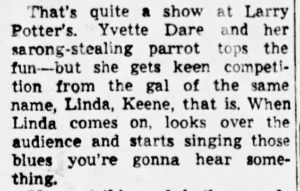 Linda would receive a good review from the Valley Times (North Hollywood, California), on the right, in their February 17th edition. As before, when she had performed at Larry Potter’s in 1949, small notices appeared again about a new song she was singing.
Linda would receive a good review from the Valley Times (North Hollywood, California), on the right, in their February 17th edition. As before, when she had performed at Larry Potter’s in 1949, small notices appeared again about a new song she was singing. Again, I have no idea what the song “Billy! Let Me Go!” refers to. As in 1949, this wire service notice ran during her engagement and into March, like the above notice from the Stephens Star, Stephens, Arkansas that appeared March 1st, 1950.
Again, I have no idea what the song “Billy! Let Me Go!” refers to. As in 1949, this wire service notice ran during her engagement and into March, like the above notice from the Stephens Star, Stephens, Arkansas that appeared March 1st, 1950.
In April of 1950 Linda Keene was back in the newspaper again but not for any appearances.  Linda Keene’s picture appeared in the The Los Angeles Times on April 29th along with her friend, comedienne Mable Todd. Linda was a witness who provided testimony in the divorce proceedings of Mable Todd against her husband Matthew Santino.
Linda Keene’s picture appeared in the The Los Angeles Times on April 29th along with her friend, comedienne Mable Todd. Linda was a witness who provided testimony in the divorce proceedings of Mable Todd against her husband Matthew Santino.  Jumping ahead a bit, Mabel Todd and Linda Keene were linked again in a wire service article that ran in newspapers the week of June 10th. The article mentions a four week tour of hospital shows in Montana starring Keene and Todd. It’s odd that this article appeared in June but notes that Todd’s divorce wouldn’t be final until April. Was that the April that just passed or was she referring to April of 1951? Even odder is that Linda Keene was performing in Montana but it was in May of 1950 before this article appeared; suggesting the June article should have appeared in March or April of 1950.
Jumping ahead a bit, Mabel Todd and Linda Keene were linked again in a wire service article that ran in newspapers the week of June 10th. The article mentions a four week tour of hospital shows in Montana starring Keene and Todd. It’s odd that this article appeared in June but notes that Todd’s divorce wouldn’t be final until April. Was that the April that just passed or was she referring to April of 1951? Even odder is that Linda Keene was performing in Montana but it was in May of 1950 before this article appeared; suggesting the June article should have appeared in March or April of 1950.
Linda’s appearance in Montana was at the Legion Club in Great Falls, Montana.
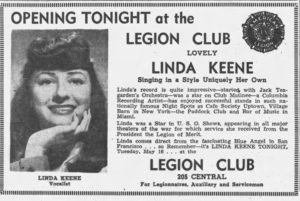 Linda’s engagement at the Legion Club began on May 16th, as referenced in the advertisement above from the Great Falls Tribune (Great Falls, Montana) on that date. It’s interesting to note from the advertisement that she had appeared at “Cafe Society Uptown, Village Barn in New York, the Paddock Club and Bar of Music in Miami.” We know of course about her appearance at the Cafe Society Uptown in July of 1941 but nothing of the other venues. Perhaps the Village Barn is a reference to the Village Vanguard where she appeared in December of 1945. The advertisement also notes that she “comes directly from the Blue Angel in San Francisco” but that might have referred to her December 1949 engagement there. It’s also interesting that the advertisement makes reference to her USO work and that she received the Legion of Merit from the President. I can find no reference to her Legion of Merit but it’s possible. Linda’s appearance at the Legion Club was likely only for a week as there were no other advertisements after this one that appeared in the Great Falls Tribune on May 20th:
Linda’s engagement at the Legion Club began on May 16th, as referenced in the advertisement above from the Great Falls Tribune (Great Falls, Montana) on that date. It’s interesting to note from the advertisement that she had appeared at “Cafe Society Uptown, Village Barn in New York, the Paddock Club and Bar of Music in Miami.” We know of course about her appearance at the Cafe Society Uptown in July of 1941 but nothing of the other venues. Perhaps the Village Barn is a reference to the Village Vanguard where she appeared in December of 1945. The advertisement also notes that she “comes directly from the Blue Angel in San Francisco” but that might have referred to her December 1949 engagement there. It’s also interesting that the advertisement makes reference to her USO work and that she received the Legion of Merit from the President. I can find no reference to her Legion of Merit but it’s possible. Linda’s appearance at the Legion Club was likely only for a week as there were no other advertisements after this one that appeared in the Great Falls Tribune on May 20th:
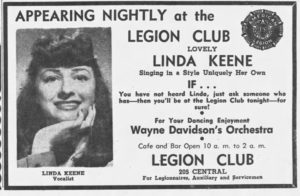 Linda and Mabel Todd did appear in Montana later in 1950 over the Labor Day Weekend. The following article appeared in The Western News from Libby, Montana, on September 7, 1950.
Linda and Mabel Todd did appear in Montana later in 1950 over the Labor Day Weekend. The following article appeared in The Western News from Libby, Montana, on September 7, 1950.
I had to cobble the article together from an article that was spread across three pages. Linda’s appearance in the stage show at the High School auditorium was summed up as “Linda Keene in the second spot earned some wolf calls as a sophisticated blues singer.” I could find no other information about the event or of any other appearance of Mabel Todd and Linda Keene in 1950.
1951
The next notice for Linda Keene wasn’t until well into 1951. In August of 1951 she was out in Colorado. 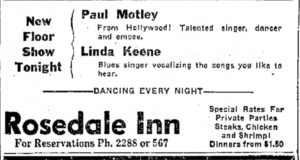 The Greeley Daily Tribune out of Greeley, Colorado ran an advertisement on August 31st for the Rosedale Inn where Linda Keene’s name was spotted among the talent. The Greeley Daily Tribune would offer up this advertisement the next day on September 1st:
The Greeley Daily Tribune out of Greeley, Colorado ran an advertisement on August 31st for the Rosedale Inn where Linda Keene’s name was spotted among the talent. The Greeley Daily Tribune would offer up this advertisement the next day on September 1st:  Linda only appeared at the Rosedale Inn for a week from August 31st to September 6th. The Greeley Daily Tribune ran this advertisement on September 7th:
Linda only appeared at the Rosedale Inn for a week from August 31st to September 6th. The Greeley Daily Tribune ran this advertisement on September 7th:  For the record, the advertisement on September 8th, 1951 clarified that the “talented new artist” appearing on the bill with Paul Motley was Lou Lockwell, ‘spectacular performer on roller skates.’
For the record, the advertisement on September 8th, 1951 clarified that the “talented new artist” appearing on the bill with Paul Motley was Lou Lockwell, ‘spectacular performer on roller skates.’
The only other notice for 1951 appeared in the October 19th, 1951 issue of Down Beat.  Apparently Linda was in Chicago and looking for club work. I could find no references to her club work in Chicago in the fall of 1951.
Apparently Linda was in Chicago and looking for club work. I could find no references to her club work in Chicago in the fall of 1951.
1953
After the October 1951 notice in Down Beat, I could find no other media notices for Linda Keene until the summer of 1953. I have searched through the back catalogue of available newspapers as well as issues of Billboard, Variety, and Down Beat for this period but found nothing for Linda Keene. At this point, her career was waning and she was relegated to club work where she was not the headliner in some cases. Sometimes she appeared in Canada, like the time she appeared at the Gatineau Club in Quebec. Just because I could find no notices for her from fall of 1951 to summer of 1953 doesn’t mean she wasn’t working. Her name just might not have been prominent but she was still receiving some notices. Referring back to Professor Eves Raja’s article, “Linda Keene, Her Elusive Fame”, he had this to say about this time period in her life:
Her manager Stillman Pond could not get her a break with the Hollywood studio establishment. Linda’s final entry in Down Beat came on Oct. 19, 1951…”Linda, after several years on the West Coast blew into Chicago and plans to stick around doing club work….Despite the positive reviews form her many admirers Linda’s career petered out in the early 1950s.”
Opal Nations’ article, ” ‘Unlucky Woman’ – The Story of Linda Keene”, concurred with Professor Raja regarding Linda’s 1950s work:
“…Down Beat Magazine reported the odd engagement Keene played in San Francisco and Las Vegas…Keene had moved to Chicago and was looking for work. She wound up living in Hollywood.”
By July of 1953, Linda Keene was once more on the East Coast, appearing this time at the Musi-Club in Troy, New York: 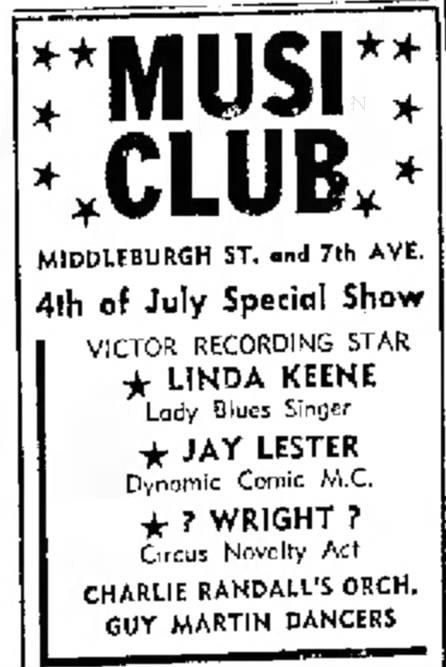 I believe the opening date for Linda’s engagement at the Musi-Club was Friday, July 3rd, 1953 and the engagement ran well into August. By August 7th the line-up of talent had changed but Linda Keene was still in the mix:
I believe the opening date for Linda’s engagement at the Musi-Club was Friday, July 3rd, 1953 and the engagement ran well into August. By August 7th the line-up of talent had changed but Linda Keene was still in the mix: 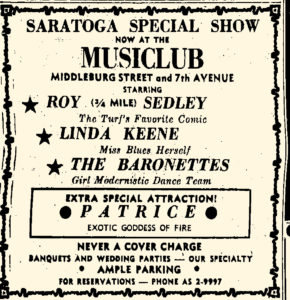 The same advertisement as the one above from the Troy Times Record, Troy, New York, would run up to Saturday, August 15th. It is likely that the engagement concluded on Thursday, August 27th.
The same advertisement as the one above from the Troy Times Record, Troy, New York, would run up to Saturday, August 15th. It is likely that the engagement concluded on Thursday, August 27th.
The following month, September, Linda was still on the East Coast, appearing at the Hollywood Restaurant in Pittsfield, Massachusetts. The advertisement below appeared in the The Berkshire Eagle (Pittsfield, Massachusetts) on September 21st.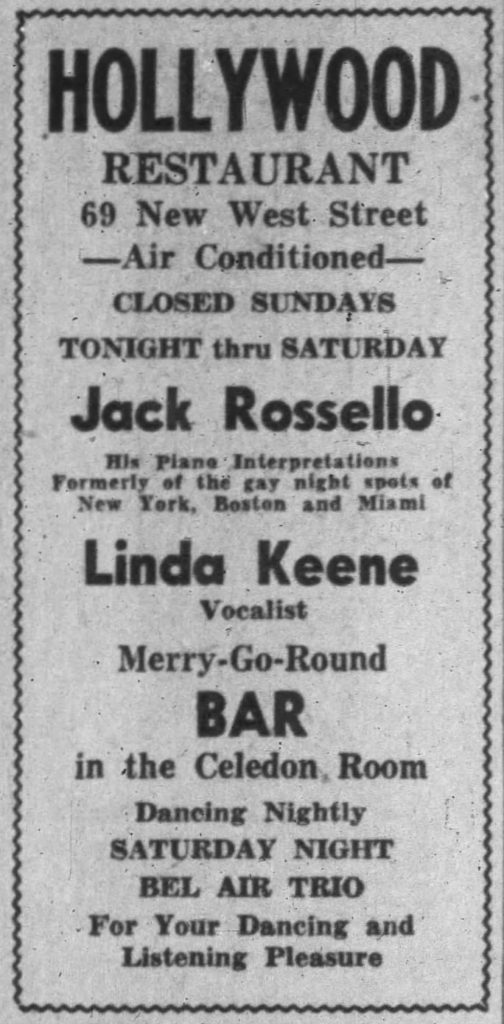 According to the advertisement, Linda opened on Monday, September 21st and appeared through Saturday, September 26th. All other advertisements for the Hollywood Restaurant for that week were the same as the one above. On September 28th, the Hollywood Restaurant advertisement still featured Jack Rossello but the vocalist spot had been replaced by Marsha Carrol.
According to the advertisement, Linda opened on Monday, September 21st and appeared through Saturday, September 26th. All other advertisements for the Hollywood Restaurant for that week were the same as the one above. On September 28th, the Hollywood Restaurant advertisement still featured Jack Rossello but the vocalist spot had been replaced by Marsha Carrol.
In October of 1953 Linda was up in Providence, Rhode Island at the Hi-Way Casino. The following advertisement appeared in the Providence Journal on October 24th, 1953: 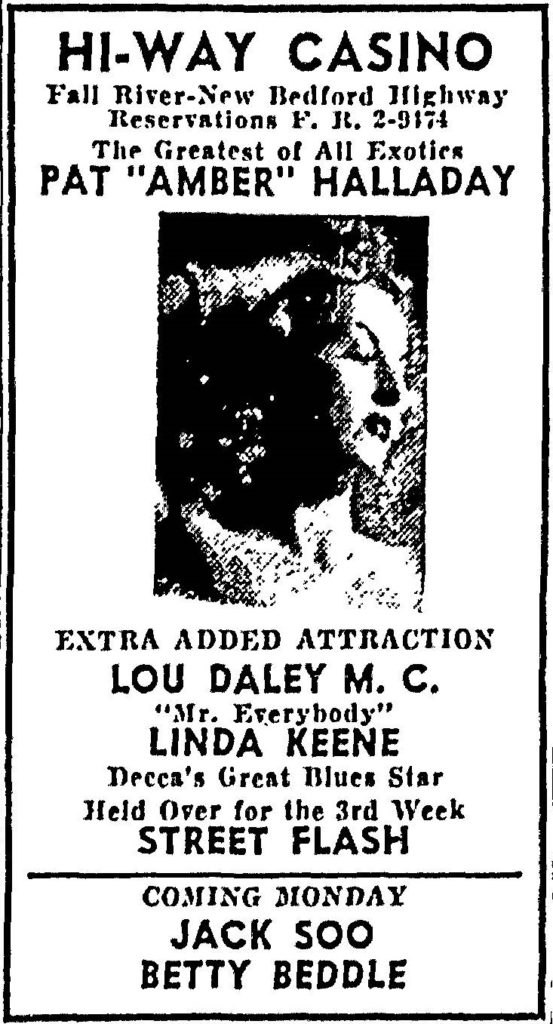 Notice that Linda Keene was now being billed as Decca’s Great Blues Star. There is no evidence that Linda Keene ever recorded for the Decca label. I checked through all of the editions of the Providence Journal for the week preceding and the week following the above advertisement from October 24th but found no other advertisements for the Hi-Way Casino. Assuming that “Coming Monday”, which would have been Monday, October 26th, from the above advertisement suggests that the program changed on Mondays. From that, it is safe to assume that Linda Keene likely appeared at the Hi-Way Casino from October 19th to October 25th. By the way, Jack Soo, who started on the 26th, would go on to play the very funny character of Detective Sergeant Nick Yemana from 1975 to 1982 on the hilarious “Barney Miller” television show.
Notice that Linda Keene was now being billed as Decca’s Great Blues Star. There is no evidence that Linda Keene ever recorded for the Decca label. I checked through all of the editions of the Providence Journal for the week preceding and the week following the above advertisement from October 24th but found no other advertisements for the Hi-Way Casino. Assuming that “Coming Monday”, which would have been Monday, October 26th, from the above advertisement suggests that the program changed on Mondays. From that, it is safe to assume that Linda Keene likely appeared at the Hi-Way Casino from October 19th to October 25th. By the way, Jack Soo, who started on the 26th, would go on to play the very funny character of Detective Sergeant Nick Yemana from 1975 to 1982 on the hilarious “Barney Miller” television show.
Linda followed up the Hi-Way Casino 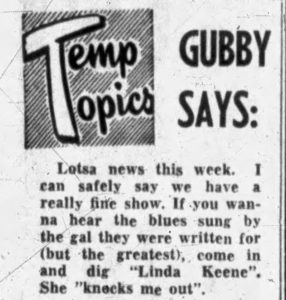 engagement by appearing at the Temp Tropics in Waterville, Maine in November of 1953. The article to the left appeared in the Morning Sentinel on November 12, 1953; highlighting Linda Keene’s appearance. I could not find a start or end date for Linda Keene at the Temp Tropics.
engagement by appearing at the Temp Tropics in Waterville, Maine in November of 1953. The article to the left appeared in the Morning Sentinel on November 12, 1953; highlighting Linda Keene’s appearance. I could not find a start or end date for Linda Keene at the Temp Tropics.
An an interesting article appeared in the  The Oneonta Star (Oneonta, New York), on December 12th, 1953. Before commenting on Linda Keene at the Windsor, I want to highlight the statement “Linda is just back from the Copa in Montreal.” Given that the engagement at the Hi-Way Casino in Providence, Rhode Island ended on October 26th, I searched through English and French language newspapers in Montreal for any notices of Linda Keene’s appearance at the Copa. I could find nothing from the end of October through the first week of December. She might have been in Montreal but her run at the Copa failed to generate any noticeable press. I also checked all of the advertisements for Linda Keene at the Windsor Hotel in Oneonta, New York for the month of December but her name is not mentioned. Linda Keene’s name does appear in advertisements for the Windsor Hotel but not until January of 1954.
The Oneonta Star (Oneonta, New York), on December 12th, 1953. Before commenting on Linda Keene at the Windsor, I want to highlight the statement “Linda is just back from the Copa in Montreal.” Given that the engagement at the Hi-Way Casino in Providence, Rhode Island ended on October 26th, I searched through English and French language newspapers in Montreal for any notices of Linda Keene’s appearance at the Copa. I could find nothing from the end of October through the first week of December. She might have been in Montreal but her run at the Copa failed to generate any noticeable press. I also checked all of the advertisements for Linda Keene at the Windsor Hotel in Oneonta, New York for the month of December but her name is not mentioned. Linda Keene’s name does appear in advertisements for the Windsor Hotel but not until January of 1954.
1954
The first advertisement for Linda Keene at the Windsor Hotel appeared in The Oneonta Star on January 2nd, 1954. 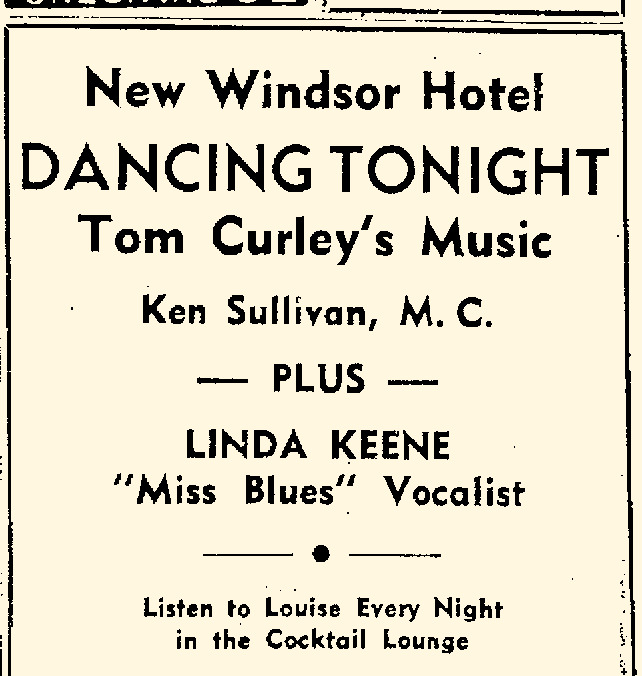
Other advertisements for the New Windsor Hotel noted that the program usually changed on a Friday. The Friday before the January 2nd, 1954 advertisement appeared was New Year’s Eve, December 31st, 1953. Here is the advertisement that appeared in the Oneonta Star on December 31st: 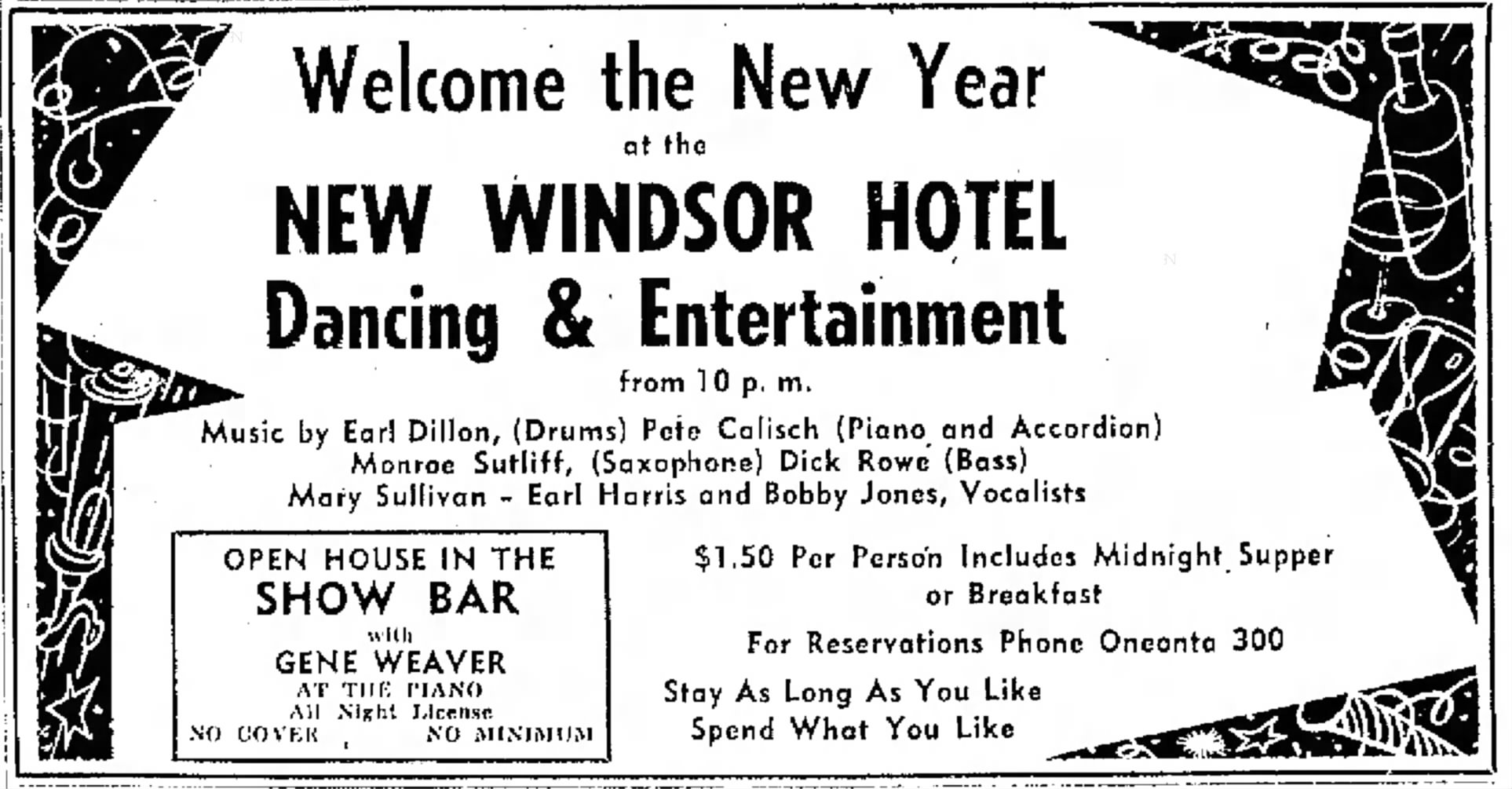
Note that Linda Keene’s name does not appear. The following day, Saturday, January 1st, 1954 was a holiday and the New Windsor Hotel was probably closed; making January 2nd, 1954, Linda Keene’s debut at the Hotel. Other advertisements that were published during Linda’s engagement at the New Windsor Hotel would prominently feature her name and picture: 
Linda Keene appeared at the New Windsor Hotel from January 2nd to January 14th, with her last press appearing in the Troy Times Record, Troy, New York on January 11th. 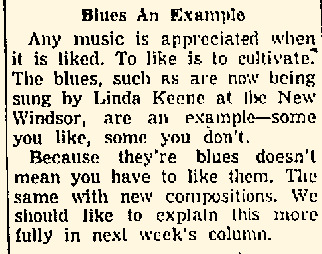 Despite a promise to revisit the issue of Blues music in a subsequent issue, I could find nothing for the remainder of January where the Troy Times Record revisited the subject.
Despite a promise to revisit the issue of Blues music in a subsequent issue, I could find nothing for the remainder of January where the Troy Times Record revisited the subject.
After her January appearance at the New Windsor Hotel in Oneonta, New York, Linda Keene’s name is absent from any media I could find until late May of 1954. The Newburgh News on May 28, 1954 had her appearing at the Crystal Lake Restaurant in Newburgh, New York:
Linda had last played Newburgh for a one night only appearance at the Ritz Theatre on February 24th, 1942. The Crystal Lake Restaurant appearance likely began on May 28th, 1954 because it was a Friday evening. The Newburgh News was still advertising Linda at the Crystal Lake Restaurant as late as June 11th, 1954, suggesting a 2 or possible 3 week run in Newburgh:
The next news of Linda Keene was until August of 1954. 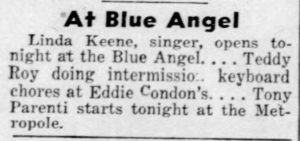 On August 6th, the New York Daily News reported that Linda Keene was opening at the Blue Angel in New York. Linda Keene was supposedly last at the Blue Angel in May or June of 1948 but I could not find any media for that engagement. Linda’s return to the Blue Angel, and indeed New York, was so significant that the New York Daily News played it up in their August 14th edition and also included her picture:
On August 6th, the New York Daily News reported that Linda Keene was opening at the Blue Angel in New York. Linda Keene was supposedly last at the Blue Angel in May or June of 1948 but I could not find any media for that engagement. Linda’s return to the Blue Angel, and indeed New York, was so significant that the New York Daily News played it up in their August 14th edition and also included her picture: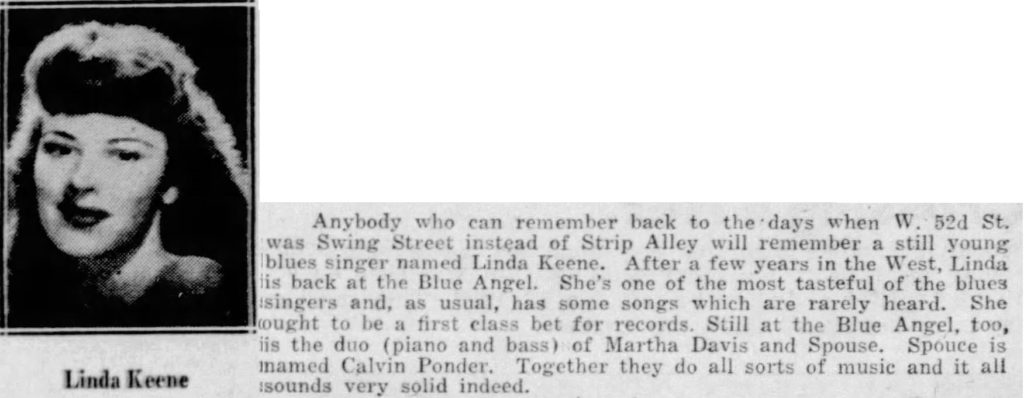 It might have been significant to the New York Daily News that Linda Keene was back in New York at the Blue Angel but neither Billboard or Variety would make any reference to her. Variety’s list of performers at the Blue Angel for August failed to mention Linda Keene at all. Linda’s engagement at the Blue Angel was likely for two weeks, ending on August 19th.
It might have been significant to the New York Daily News that Linda Keene was back in New York at the Blue Angel but neither Billboard or Variety would make any reference to her. Variety’s list of performers at the Blue Angel for August failed to mention Linda Keene at all. Linda’s engagement at the Blue Angel was likely for two weeks, ending on August 19th.
Linda continued working on the East Coast in the last half of 1954. She returned to Pittsfield, Massachusetts in November of 1954 at Frankie and Johnnie’s. The Berkshire Eagle (Pittsfield, Massachusetts) ran the advertisement below on November 1st, 1954: 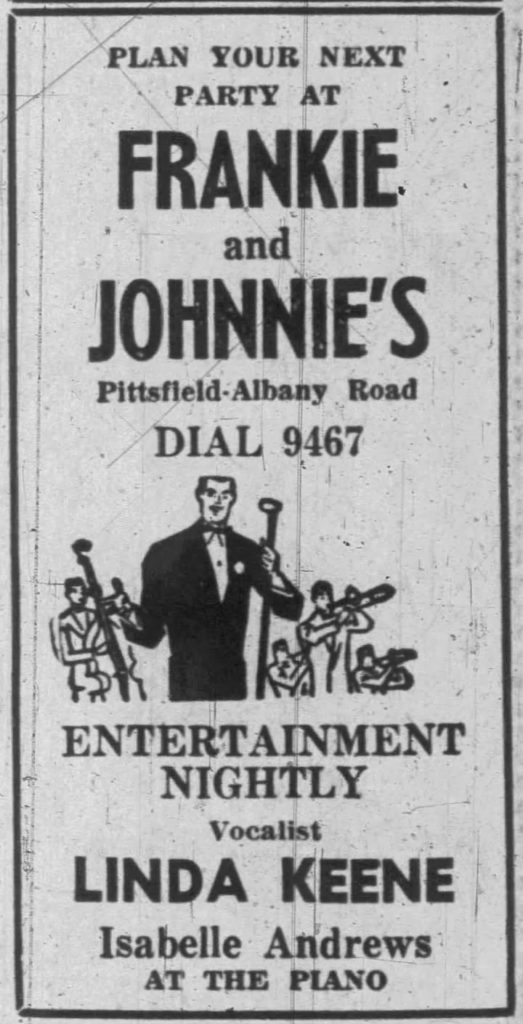
When Linda performed in September of 1953 in Pittsfield, she was at the Hollywood Restaurant. In November of 1954 she was at Frankie and Johnnie’s which ironically was the name of one of the Soundies she filmed in 1942. This was a one week engagement ending on November 7th, 1954. On November 8th, the vocalist Lisa Mansfield would open at Frankie and Johnnie’s.
The night after closing at Frankie and Johnnie’s in Pittsfield, Massachusetts, Linda was over in Utica, New York on November 8th opening at The Silver Rail.
The Utica Observer Dispatch made use of the New York Daily News August 14th edition that highlighted Linda Keene’s appearance at the Blue Angel. The same advertisement would appear in the Utica Observer Dispatch for Linda’s one week engagement that closed on November 14th, 1954.
1955
After Utica, New York in November of 1954, Linda was still performing in New York State in January of 1955. On January 24th, 1955 the Syracuse Herald Journal published an advertisement for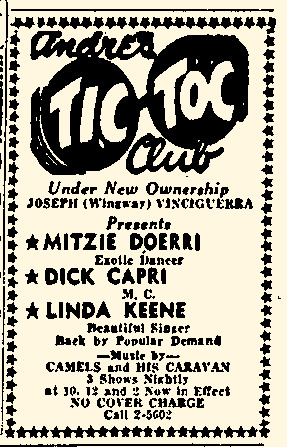 Andre’s Tic-Toc Club in Syracuse, New York. Linda had last performed in Syracuse twenty years earlier in 1935, under her married name Florence Suttle, with George Duffy and his Orchestra at the Hotel Syracuse. Her engagement at Andre’s Tic-Toc Club would be for a week from January 24th to January 30th. Linda Keene would return again to the Tic-Toc Club but it wouldn’t be for another three years.
Andre’s Tic-Toc Club in Syracuse, New York. Linda had last performed in Syracuse twenty years earlier in 1935, under her married name Florence Suttle, with George Duffy and his Orchestra at the Hotel Syracuse. Her engagement at Andre’s Tic-Toc Club would be for a week from January 24th to January 30th. Linda Keene would return again to the Tic-Toc Club but it wouldn’t be for another three years.
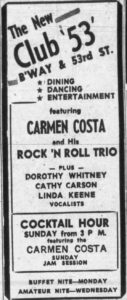 The next sighting of Linda Keene, that I could find, for 1955 wasn’t until October when she’s part of the bill at the New Club ’53’ in Bayonne, New Jersey. The advertisement to the left appeared in the Bayonne Times on October 7th. This same ad would appear in the Bayonne Times up to and including November 11th with the same artists all appearing.
The next sighting of Linda Keene, that I could find, for 1955 wasn’t until October when she’s part of the bill at the New Club ’53’ in Bayonne, New Jersey. The advertisement to the left appeared in the Bayonne Times on October 7th. This same ad would appear in the Bayonne Times up to and including November 11th with the same artists all appearing. 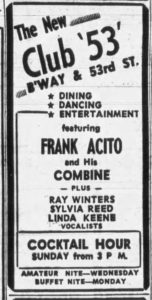 On November 18th the advertisement on the right started appearing with Frank Acito replacing Carmen Costa as the main attraction. Gone also were Dorothy Whitney and Cathy Carson, being replaced by Ray Winters and Sylvia Reed. Linda was the only performer still held over from October. On November 26th, the lineup changed again and Linda’s name was no longer appearing. This would have been a nice six week engagement for Linda Keene:
On November 18th the advertisement on the right started appearing with Frank Acito replacing Carmen Costa as the main attraction. Gone also were Dorothy Whitney and Cathy Carson, being replaced by Ray Winters and Sylvia Reed. Linda was the only performer still held over from October. On November 26th, the lineup changed again and Linda’s name was no longer appearing. This would have been a nice six week engagement for Linda Keene:
1958
Linda Keene’s career was most definitely slowing down. After the New Club ’53’ in Bayonne appearance in November of 1955, I could not track her again until almost three years later when she was back on the West Coast. She was back at Larry Potter’s Supper Club in Los Angeles. 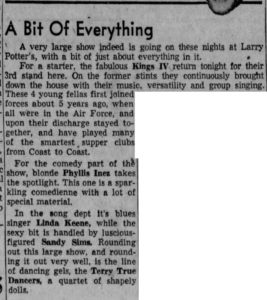 It had been eight years since the last advertisement featuring Linda Keene at Larry Potter’s in 1950. Opening on March 7th, 1958, Linda Keene would appear through to March 27th.
It had been eight years since the last advertisement featuring Linda Keene at Larry Potter’s in 1950. Opening on March 7th, 1958, Linda Keene would appear through to March 27th.  The above advertisement would appear every Friday from March 7th to March 21st in the Valley Times (North Hollywood, California). This would be Linda’s last advertisement that I could find on the West Coast.
The above advertisement would appear every Friday from March 7th to March 21st in the Valley Times (North Hollywood, California). This would be Linda’s last advertisement that I could find on the West Coast.
Finally, Linda Keene returned to Andre’s Tic-Toc Club in Syracuse, New York. Three years had passed since her January 1955 appearance at the Tic-Toc Club. Her return engagement was for a week opening on April 28th, 1958.
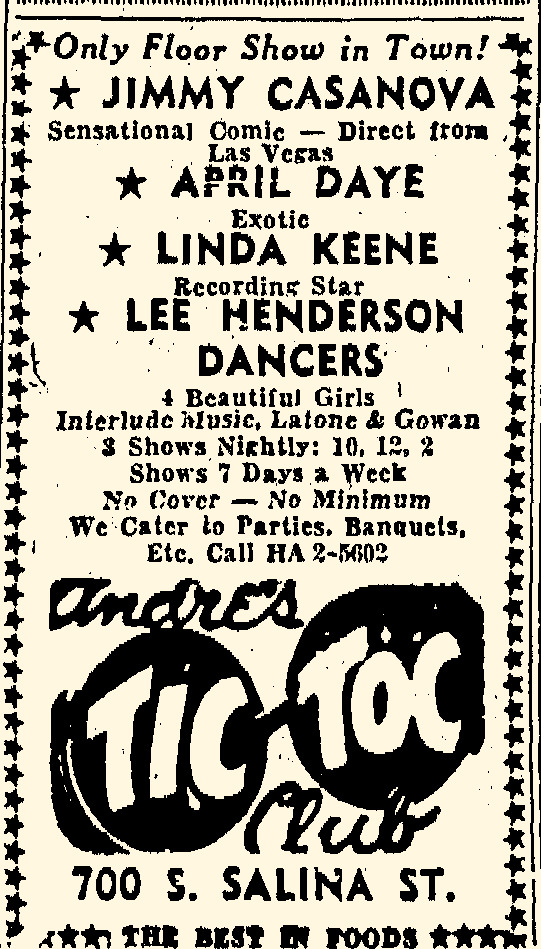 This was not only Linda Keene’s last appearance on the East Coast that I could track, it was the last known advertisement or notice for Linda Keene anywhere. Essentially, after the 1958 Tic-Toc Club appearance, she disappeared from the media altogether.
This was not only Linda Keene’s last appearance on the East Coast that I could track, it was the last known advertisement or notice for Linda Keene anywhere. Essentially, after the 1958 Tic-Toc Club appearance, she disappeared from the media altogether.
It was inevitable that the the last media notice for Linda Keene would be her obituary.  The November 7th, 1981 issue of Billboard mentioned her passing on October 23rd of that year. It is sad that it was so brief and also contained inaccuracies. Linda Keene was born Florence McCrory on December 1st, 1911 in Hattiesburg, Mississippi. This would have made her 69 years old at the time of her passing. Of course, according to Professor Raja, ““When Linda Keene arrived in Boston in the fall of 1937, she had convinced all those in the entertainment circles that she was 19 when her true age was actually 25.” Those five or six years that she shaved off her real age apparently never caught up to her even when she died. The other obvious error in the obituary was the misspelling of Bobby Hackett’s name as “Jackett.”
The November 7th, 1981 issue of Billboard mentioned her passing on October 23rd of that year. It is sad that it was so brief and also contained inaccuracies. Linda Keene was born Florence McCrory on December 1st, 1911 in Hattiesburg, Mississippi. This would have made her 69 years old at the time of her passing. Of course, according to Professor Raja, ““When Linda Keene arrived in Boston in the fall of 1937, she had convinced all those in the entertainment circles that she was 19 when her true age was actually 25.” Those five or six years that she shaved off her real age apparently never caught up to her even when she died. The other obvious error in the obituary was the misspelling of Bobby Hackett’s name as “Jackett.”
When I looked at that obituary there wasn’t a sense of completion that I had finally reached the end of my three part blahg series. What I felt was a sense of sadness. I thought I could write a better obituary than that. In fact, with this blahg series, I have. I traced Florence McCrory from her first notice regarding her High School graduation in 1929 through her marriage to Frank Suttle in September of 1931 and on to the beginnings of her career in Jackson, Mississippi in 1933. I followed her up to Detroit in 1934 and through 1935 and 1936 as she appeared throughout Ohio with her husband and bands lead by such people as Danny Rousseau, Bob Chester, George Duffy, Pinkey Hunter, Johnny Joyce, and Sam Jack Kaufman. I traced her back down to Birmingham, Alabama in May of 1936 where she appeared for two months at the Rex with Coleman Sachs and his Orchestra and then over to Atlanta, Georgia for an engagement at the Casa Loma with Buddy Fisher and his Swing Orchestra that was cut short after two weeks when the club was raided and shut down. At the end of 1936 Florence was in Philadephia at the 20th Century Club with Barney Zeeman and his Orchestra. Florence Suttle disappeared after that, only to reappear as Linda Keene with Nye Mayhew and his Orchestra at the Hotel Statler in the fall of 1937.
Tracing Linda Keene became much easier. Her career was on the rise with connections to such greats as Glenn Miller and Bobby Hackett in 1938. Linda even waxed her first recording with Hackett in November of 1938 on “Blue and Disillusioned.” This would be the first of 21 recordings from 1938 to 1945 with big names such as Jack Teagarden, Lennie Hayton, Tony Pastor, Henry Levine, Joe Marsala, and Charlie Shavers. She toured extensively with most of those bands and spent time as well fronting for orchestras and bands led by Scott Fisher, Red Nichols, Willie Farmer, Red Norvo, Muggsy Spanier, and supposedly Charlie Barnet. She took time out as well to appear in USO shows and had a successful nightclub career in the mid-1940s through the late 1950s on both the East and West Coasts of the USA and points in-between and up into Canada as well. Add to that, her three Soundies appearances with Henry Levine and radio appearances on “Strictly From Dixie” and “Club Matinee” then the sum or her career was more than could be noted in any obituary. As I said, these three blahgs are the best obituary I could write for Linda Keene.
I didn’t want to end this blahg on a sad note. Yes, it’s sad that Linda Keene didn’t have the fame she deserved but for a time, she was famous and continued to work and earn respect. I wish that I could find some of the radio programs she appeared on or any of the live remotes she did while touring with most of the bands I listed. I’ll keep looking. Both Professor Raja and Opal Nations alluded to some recordings that Linda Keene made in 1942 that were never released. Opal Nations states that “shortly before Petrillo’s AFM recording ban on July 31st, 1942, Keene managed to cut four sides with her Backroom Boys for Bob Thiele’s Signature label. This would have been at the very onset of the label’s existence. However, financial problems cancelled out the project that included a blues rendering of the Koehler-Moll-Barris song Wrap Your Troubles in Dreams.” Professor Raja also reported on the recordings but maintained it was in 1943. 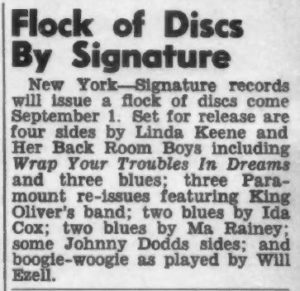 “In 1943 she waxed Wrap Your Troubles In Dreams and three blues for Bob Thiele’s Signature Records. Masters were apparently made but they never made it to the factory floor.” The August 1st, 1943 issue of Down Beat confirms it was 1943 stating the release would be around September 1st of that year. I wonder if any of these could be located?
“In 1943 she waxed Wrap Your Troubles In Dreams and three blues for Bob Thiele’s Signature Records. Masters were apparently made but they never made it to the factory floor.” The August 1st, 1943 issue of Down Beat confirms it was 1943 stating the release would be around September 1st of that year. I wonder if any of these could be located?
Failing to locate any of her radio appearances or remotes or the lost 1942/43 recordings for Signature Records, I still have something else that is phenomenal with which to end this blahg. In a previous blahg, DOWN A RABBIT HOLE WITH LINDA KEENE, I wrote about a listing on Ebay of an “Audition 78” of Linda Keene singing “Muddy Waters”. This was the picture published with the item description:
The listing description stated the following: “Linda Keene Audition Vinyl “Muddy Waters” on Gold Star 78RPM 10″ Single Sided ” I had no idea what to expect. Was this “the” Linda Keene? What was this an audition for? What was the song “Muddy Waters?” I took a chance and negotiated a price with the seller. The seller was in California and all he could tell me was that he bought it at a yard sale or flea market but no other details. Finally the record arrived and I was able to play it. Here’s what I heard:
I have not made any attempt to clean it up as I thought it would take away from the recording. If there are others more adept at cleaning audio files then I invite you to try. Needless to say, I was more than pleased and surprised to hear that this was indeed Linda Keene. It still left the mystery as to the recording but more on that in a bit. The song Muddy Water was written by Peter DeRose, Harry Richman, and Jo Trent in 1926. Here’s the sheet music for it that was published in 1926:

Bessie Smith record it in 1927 as did a young Bing Crosby with Paul Whiteman’s Orchestra in 1927. Bing would re-record the song with the Buddy Cole Trio in 1954. Part of the lyrics contain the following:
Dixie moonlight, Swanee shore
Headin’ homebound just once more
To my Mississippi delta home
Here was Linda Keene, Mississippi born, singing about her home state in what I believed was a 1950s recording.
I did not know anything about the Gold Star recording label or studio. I did some research and found a Facebook group dedicated to the Gold Star recording studio. I explained about the 78 audition record and they replied with the following:
“There was a Gold Star Recording Studio in Texas. Without seeing the label of your disc, it’s possible that it may have been cut there. Ms. Keene was a big band vocalist in the 1940’s so if she did anything at Gold Star Recording Studios in Hollywood, it would have been after 1950 when the studio opened its doors.”
I explained that Linda was living in Hollywood in the 1950s so I suspect it was done there. I also sent them a scan of the label. Here was their reply:
“That is indeed a Gold Star Recording Studios (Hollywood) disc. That was an early 1950s label design.”
The group also sent me a link regarding the three acetate label designs utilized at Gold Star during it’s thirty-three years of operation between 1950 and 1983. Gold Star Studios was a major independent recording studio located in Los Angeles, California. For more than thirty years, from 1950 to 1984, Gold Star was one of the most influential and successful commercial recording studios in the world. Founded by David S. Gold and Stan Ross and opened in October 1950, Gold Star Recording Studios was located at 6252 Santa Monica Boulevard near the corner of Vine Street in Hollywood, the studio name was a combination of the names of the two owners — (Dave) GOLD and STA(n) R(oss). The studio was renowned for its unique custom-designed recording equipment and many big bands and orchestras recorded on Gold Star. The particular label of this Linda Keene audition 78 was used up to the mid-1950s. That doesn’t narrow down the recording date but we can assume it may have been recorded when Linda Keene was on the West Coast between 1950 and 1953. I can find no other information about the recording and who performed with Linda Keene on that date.
Finding a lost or unknown Linda Keene recording is significant enough but what comes next is truly amazing. After playing the recording I was showing off the 78 to my daughter when I noticed that the flip-side of the record had what looked like residual glue marks where another label might have been. We both also noted that the flip-side appeared to have grooves. I own some one-sided 78 records and usually the unrecorded side is flat and smooth. I had to take a chance and see if the second side was playable. It was. Here’s what I heard:
Again, I haven’t cleaned up the track. What an amazing surprise! Here was a mature Linda Keene singing the ultimate saloon blues song. The song doesn’t need an explanation. “One For My Baby” was written in 1943 and was recorded by many artists but became associated with Frank Sinatra who would record the song a few times and would sing it as a standard in his concert performances. But for Linda Keene fans, this is an outstanding swan song for her career. I swear that discovering this track as an unknown track on a supposed one-sided 78 is the truth. I knew after hearing it, that it would be the closer for my last blahg entry on Linda Keene and the title of the blahg itself. It’s so fantastic a story that I couldn’t possibly make this up.
That’s it. I don’t think there’s much else to say. I don’t know if there are any other copies of this recording in existence. I also don’t know if Linda Keene recorded any other songs that day at the Gold Star studios. It was lost until it ended up in the hands of the Ebay seller from California and then was shipped out to me here in Canada. Did this once belong in Linda Keene’s own collection? She was living in California, too, at the time of her death. Did she handle this with her own two hands? We will never know. Two lost tracks that summed up her career. “Muddy Water” was a look back to her Mississippi beginnings and “One For My Baby” is a swan song of an artist who was waiting to be rediscovered and one more recording to be found…One More For The Road.
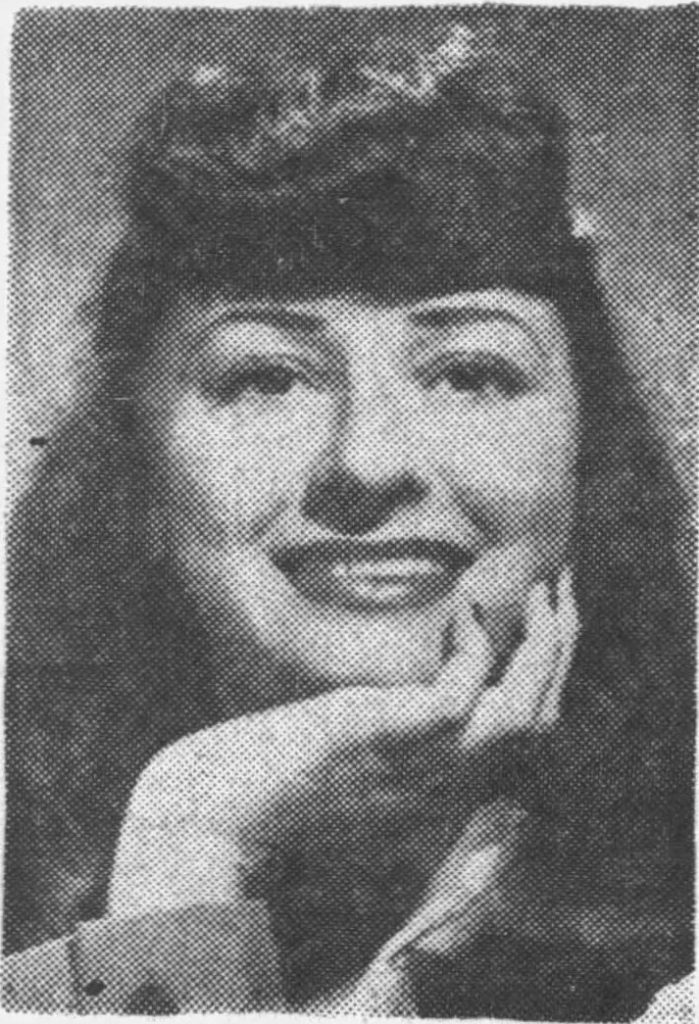

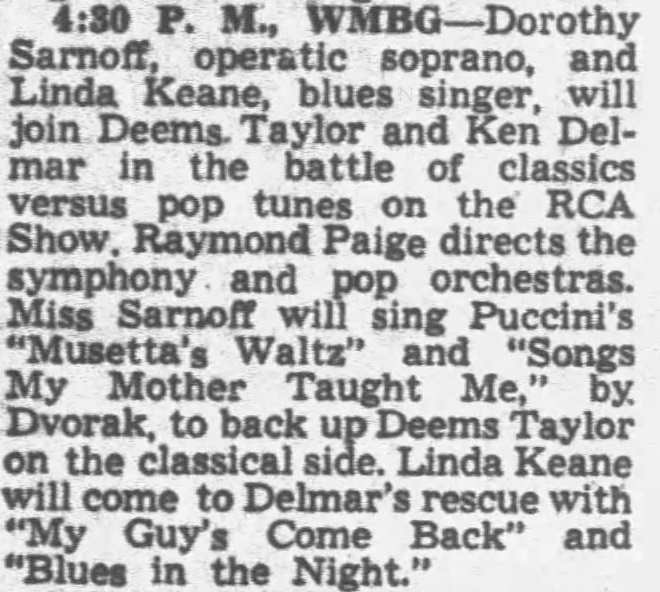
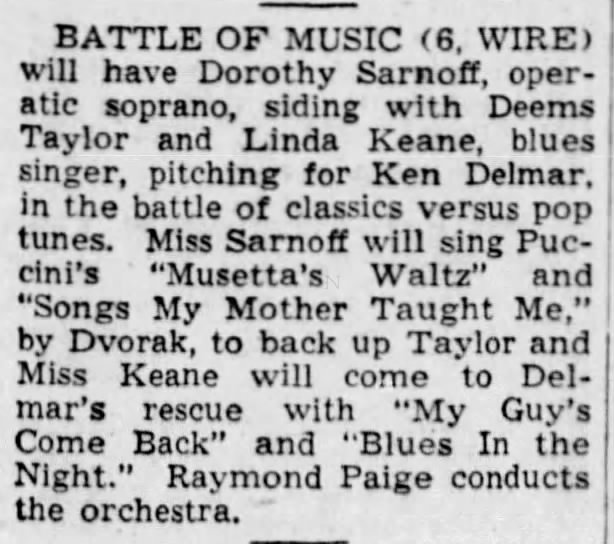

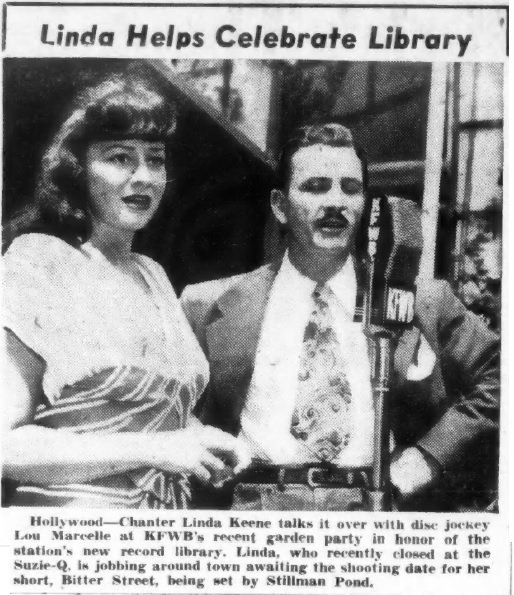

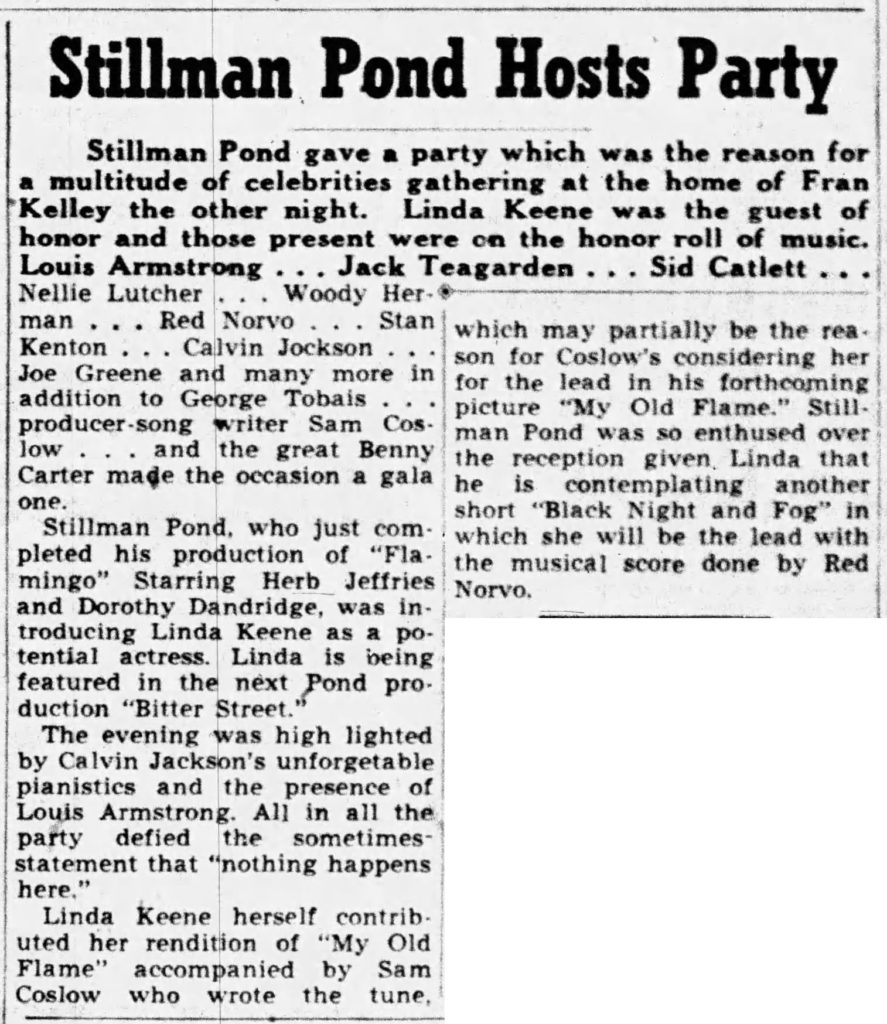
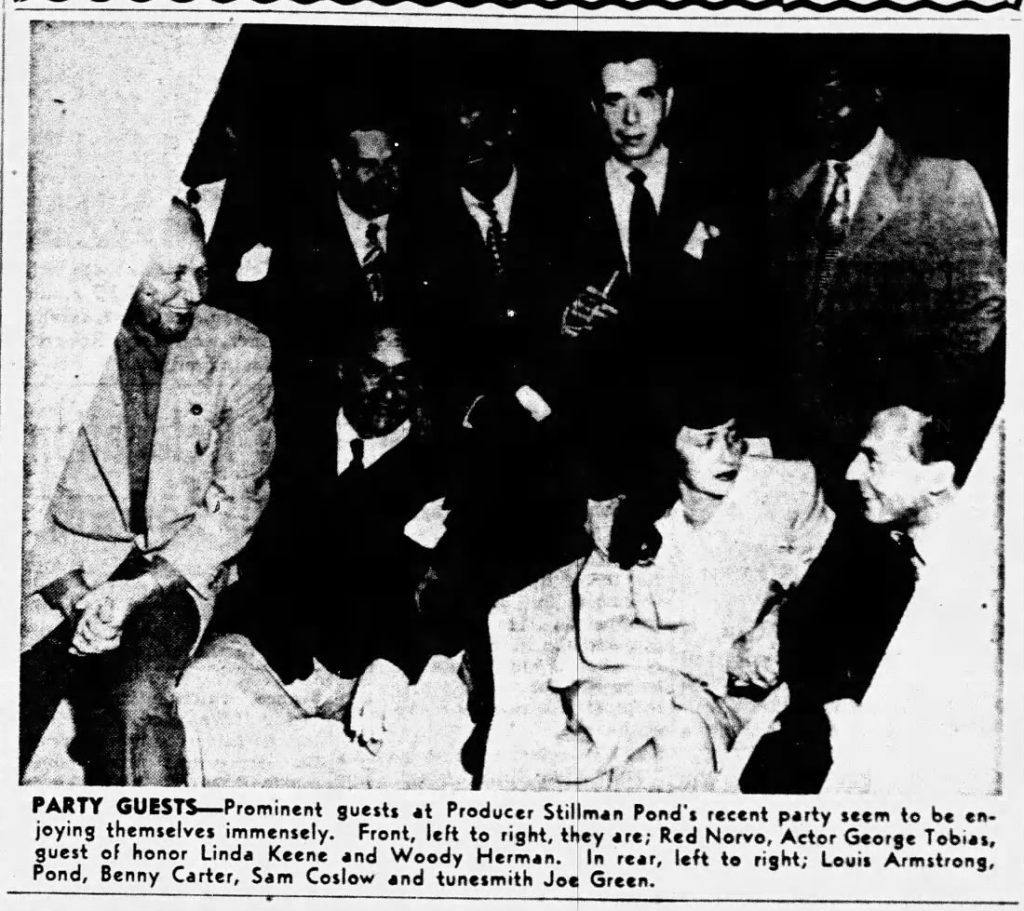

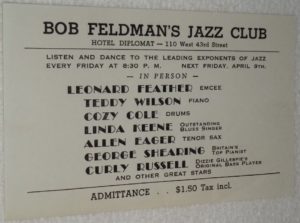


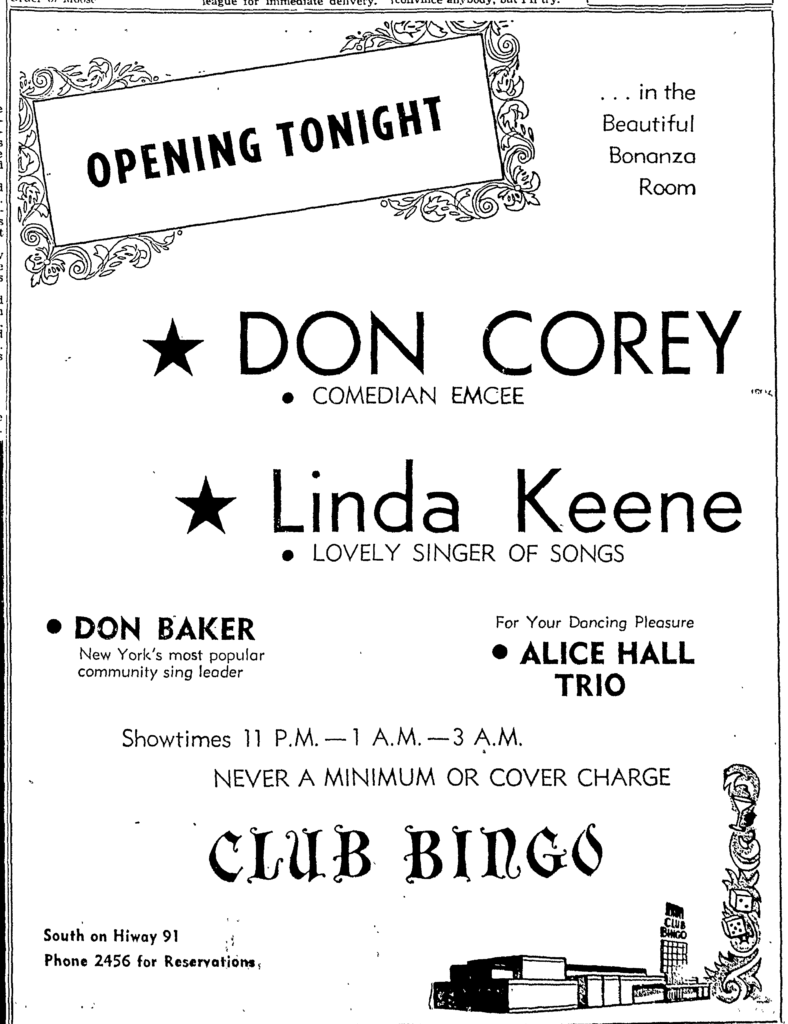
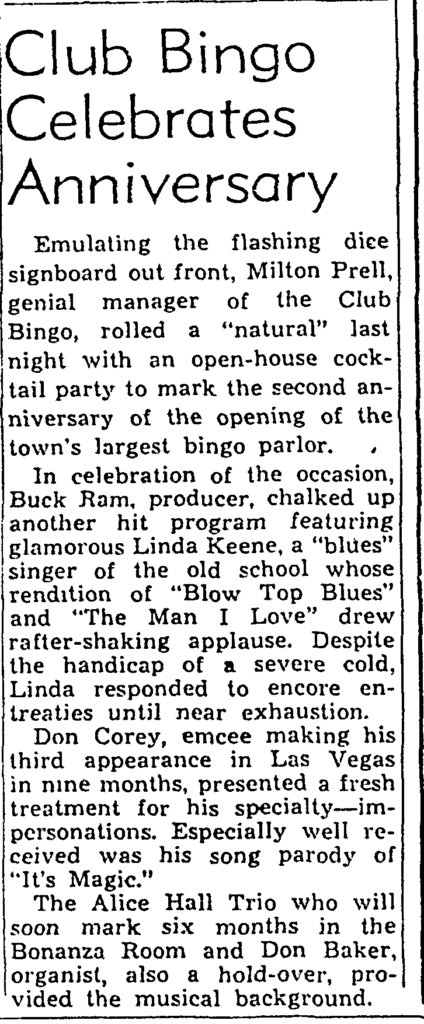
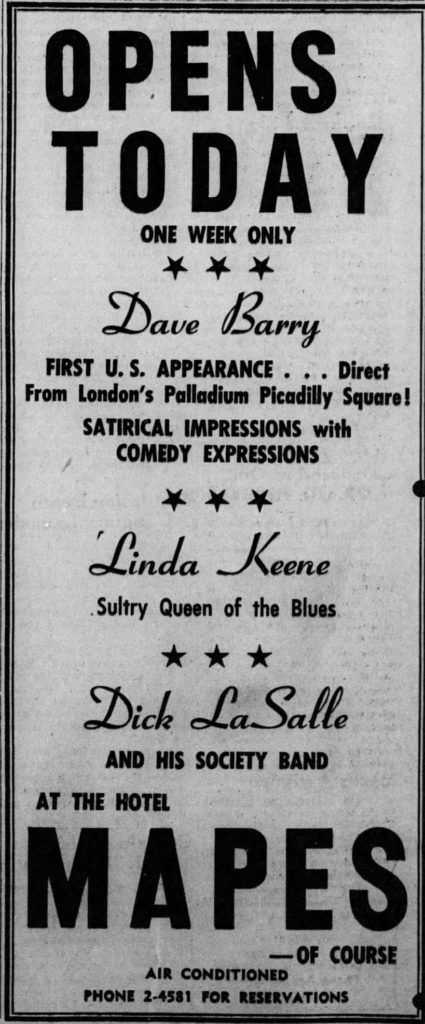
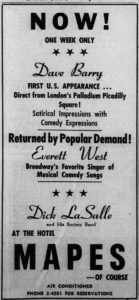
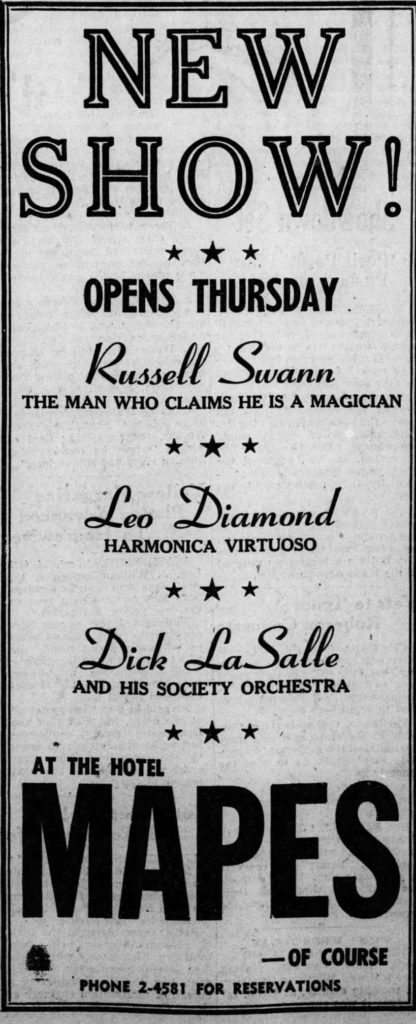

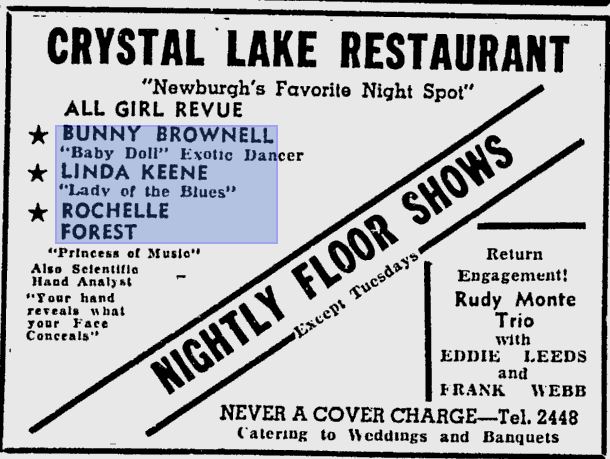
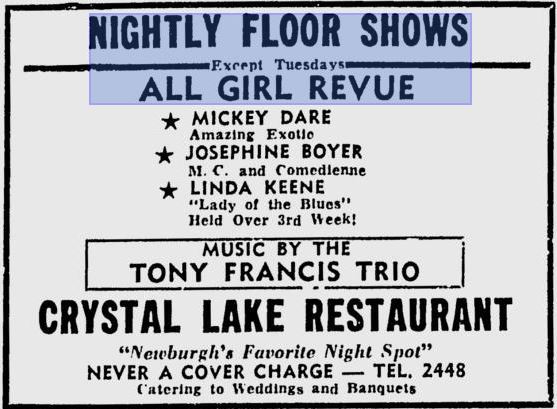
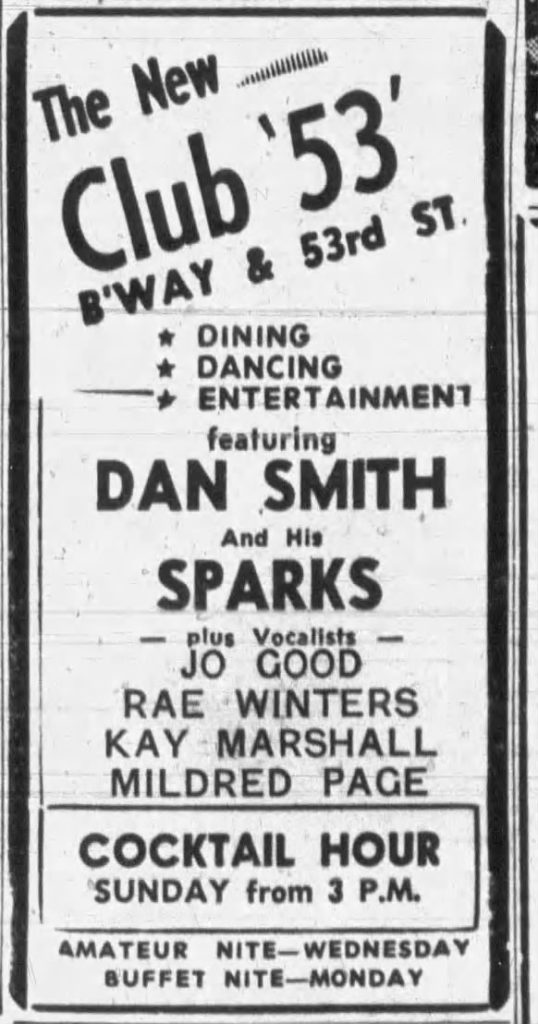
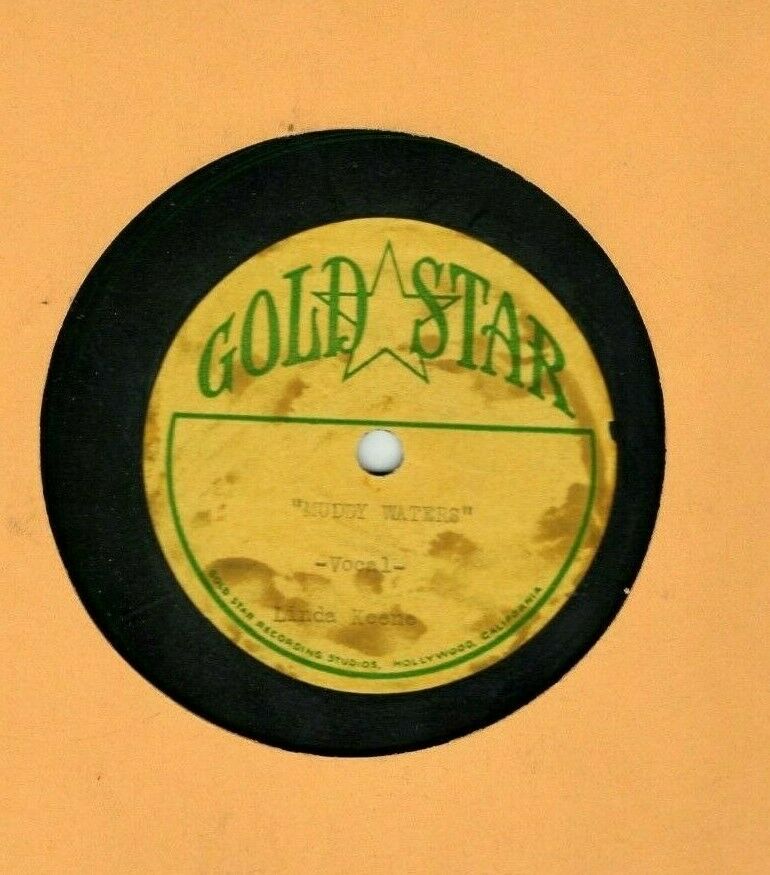
[…] This Blahg is about me and other things. « TRACING LINDA KEENE, PART 3: ONE MORE FOR THE ROAD […]
[…] http://falseducks.com/theblahg/?p=3317 […]
[…] blahg. My three part Linda Keene series, TRACING LINDA KEENE, PART 1: THE FLORENCE SUTTLE YEARS, TRACING LINDA KEENE, PART 2: THE MOMENT IN MY LIFE, TRACING LINDA KEENE, PART 3: ONE MORE FOR THE ROAD, was very labour intensive. I spent a great […]
[…] I had not known about this show and in researching it, I discovered the lovely Linda Keene…but that’s another story. If you want to know about that, start with the aforementioned Linda Keene blahg or my three part series, TRACING LINDA KEENE, PART 1: THE FLORENCE SUTTLE YEARS, TRACING LINDA KEENE, PART 2: THE MOMENT IN MY LIFE, and TRACING LINDA KEENE, PART 3: ONE MORE FOR THE ROAD. […]
[…] Keene’s version that I discovered a few years ago. You can read about that in my blahg TRACING LINDA KEENE, PART 3: ONE MORE FOR THE ROAD, and you can listen to that track […]